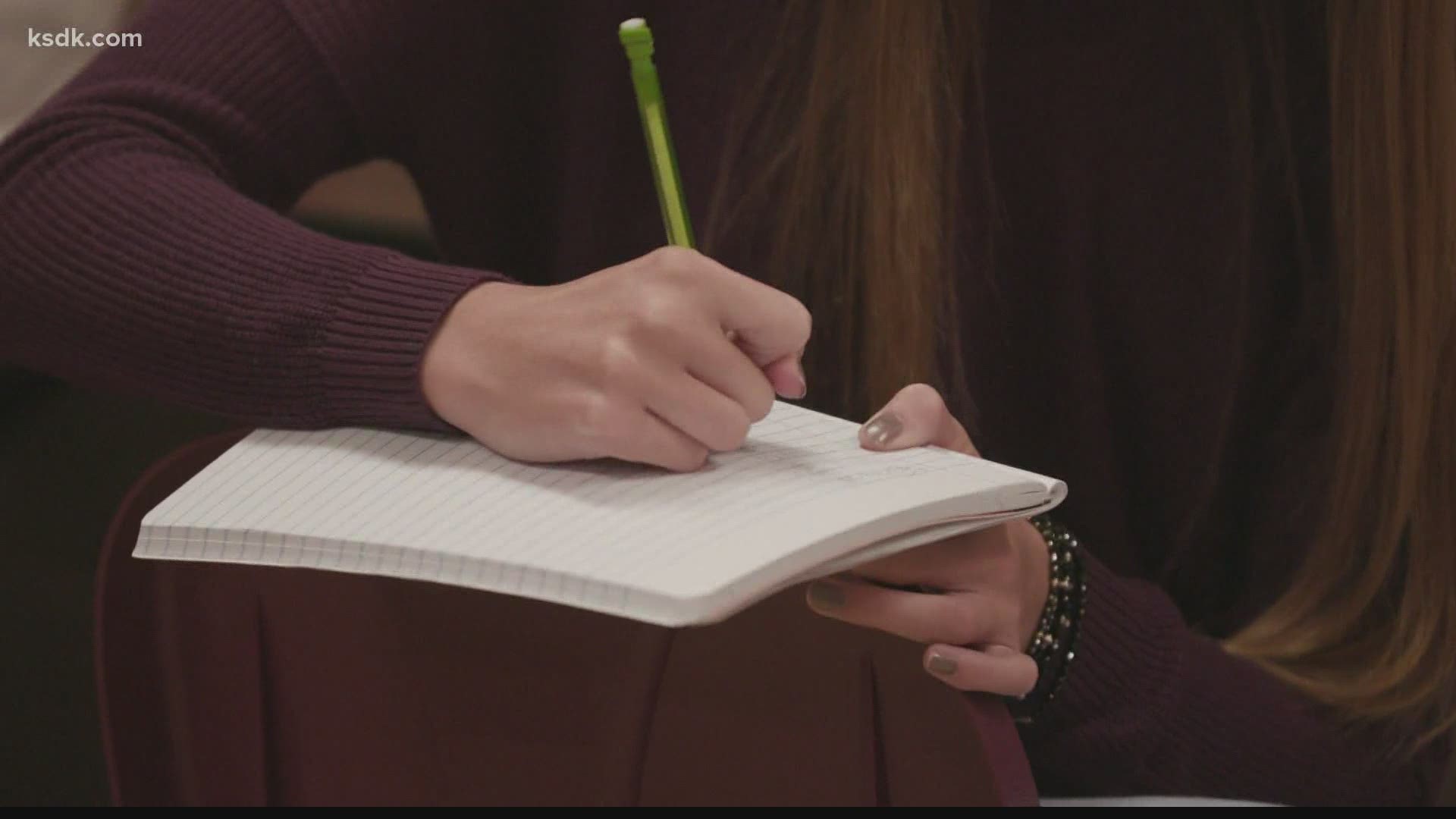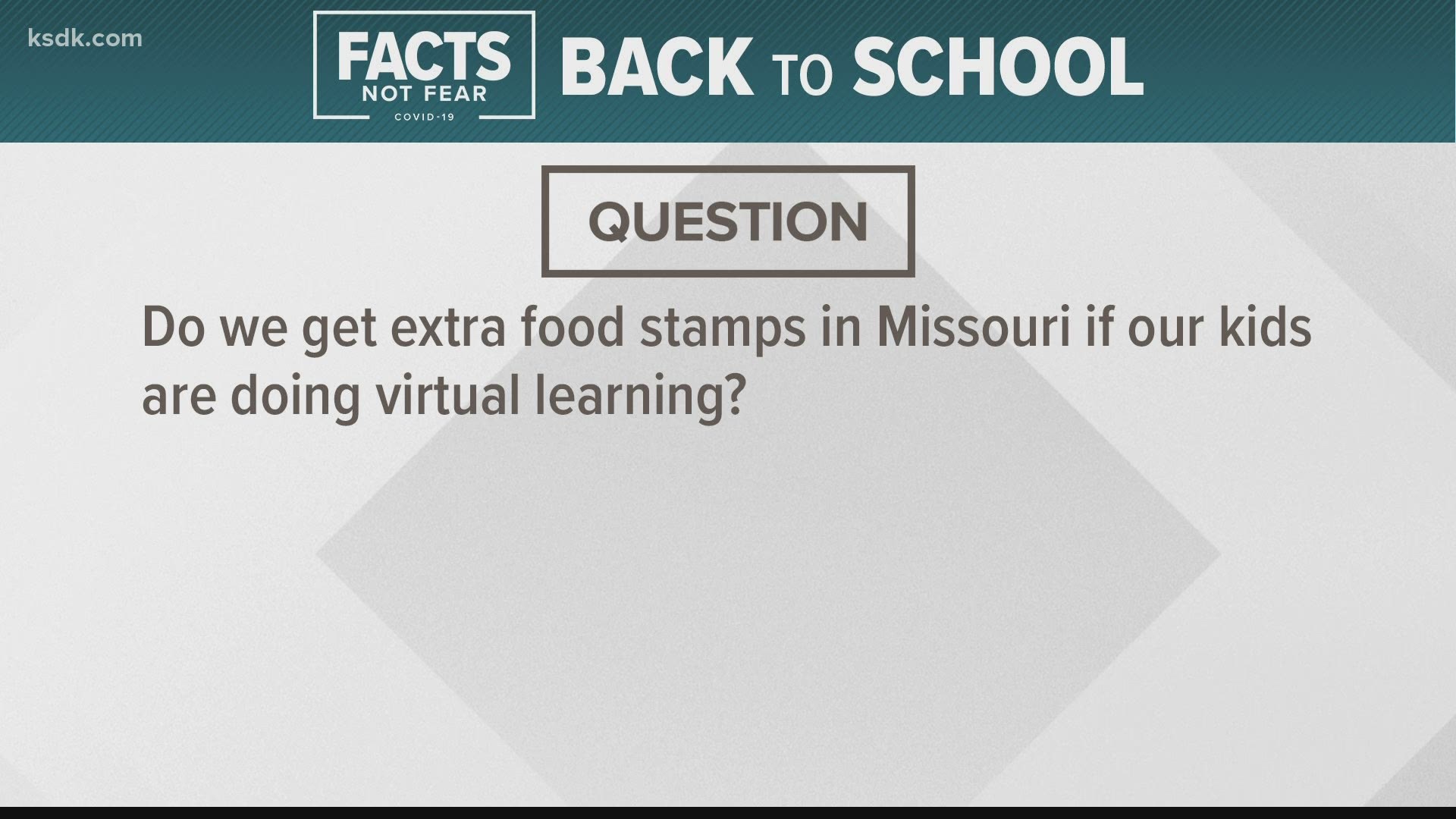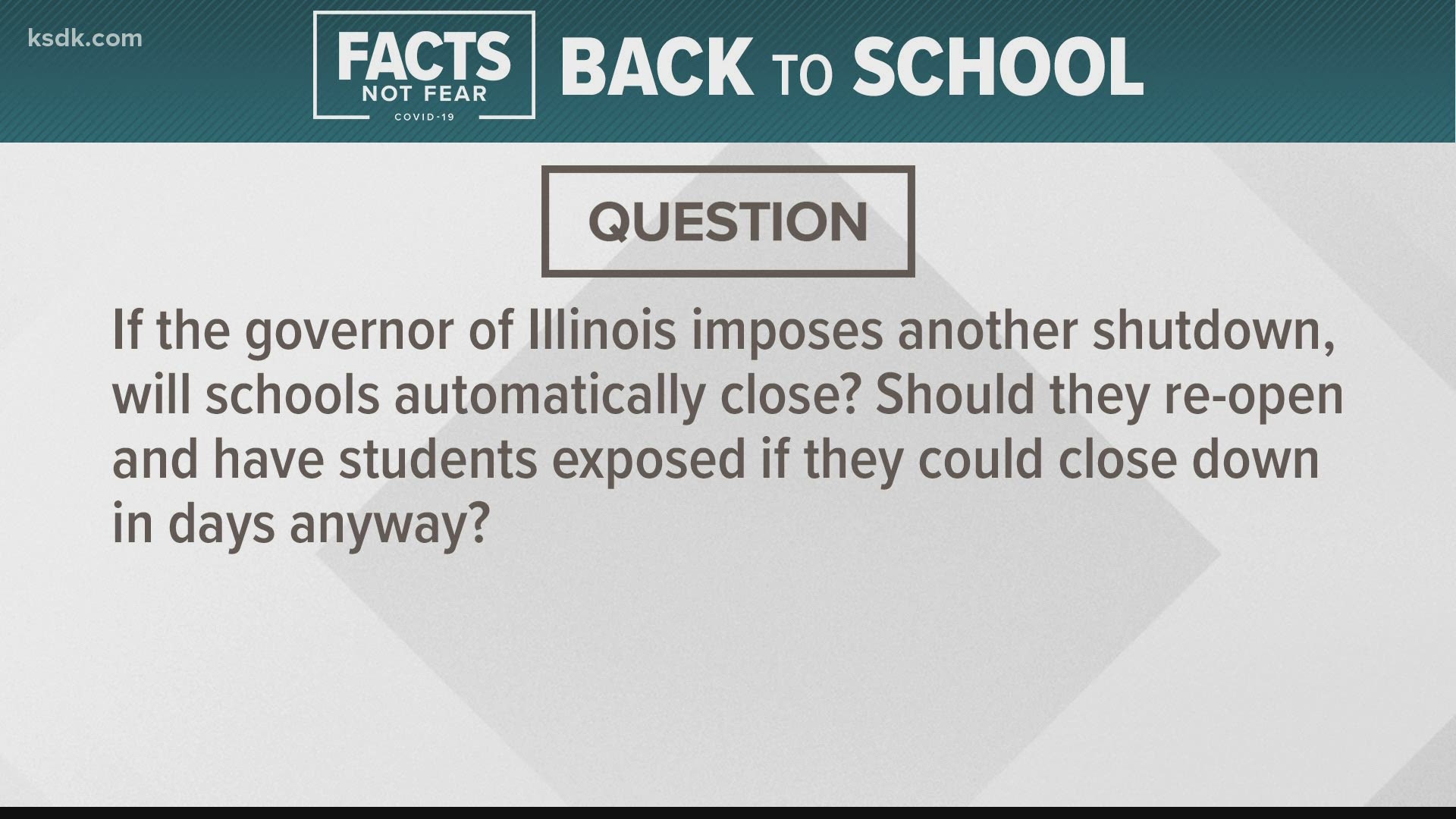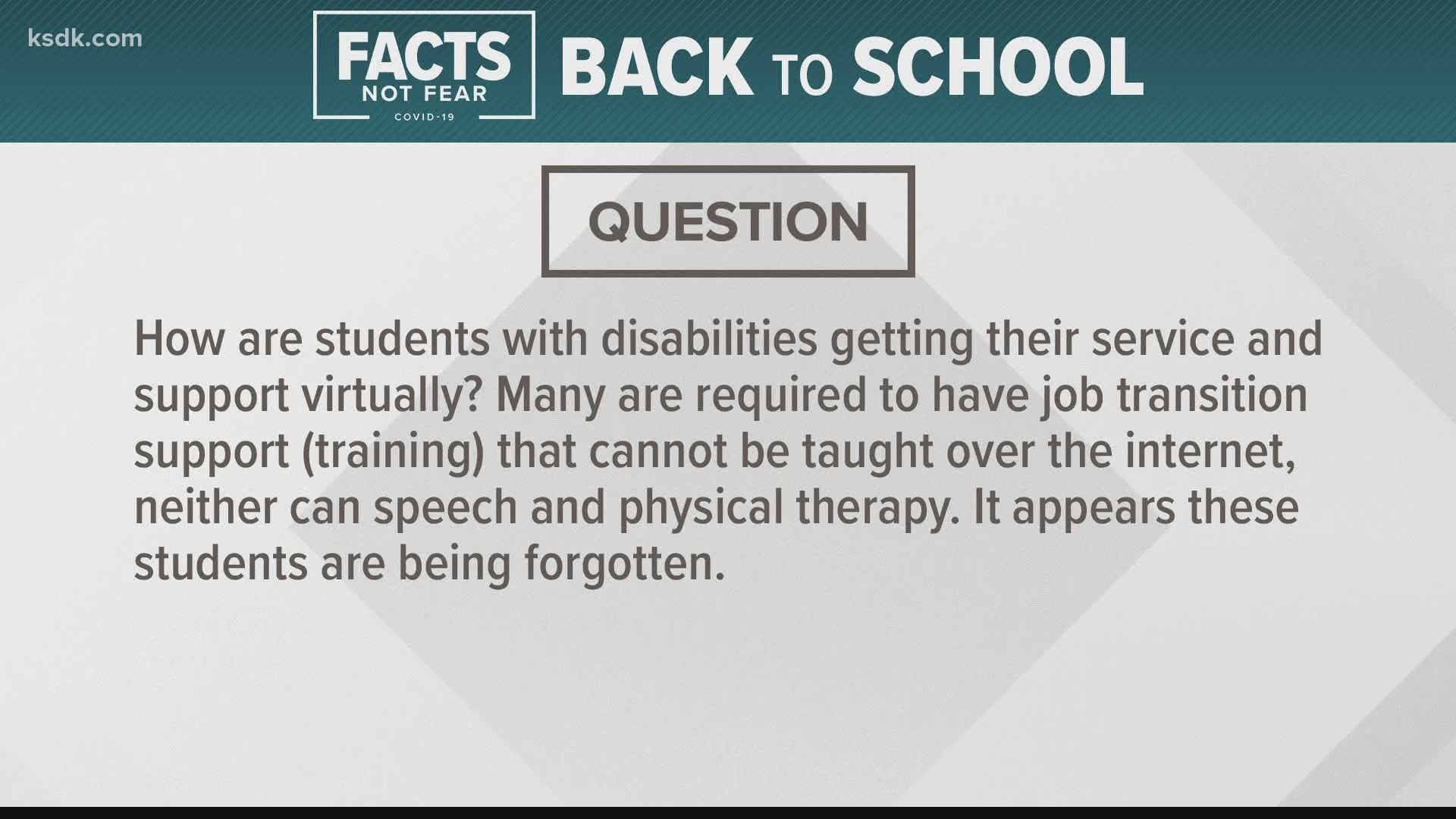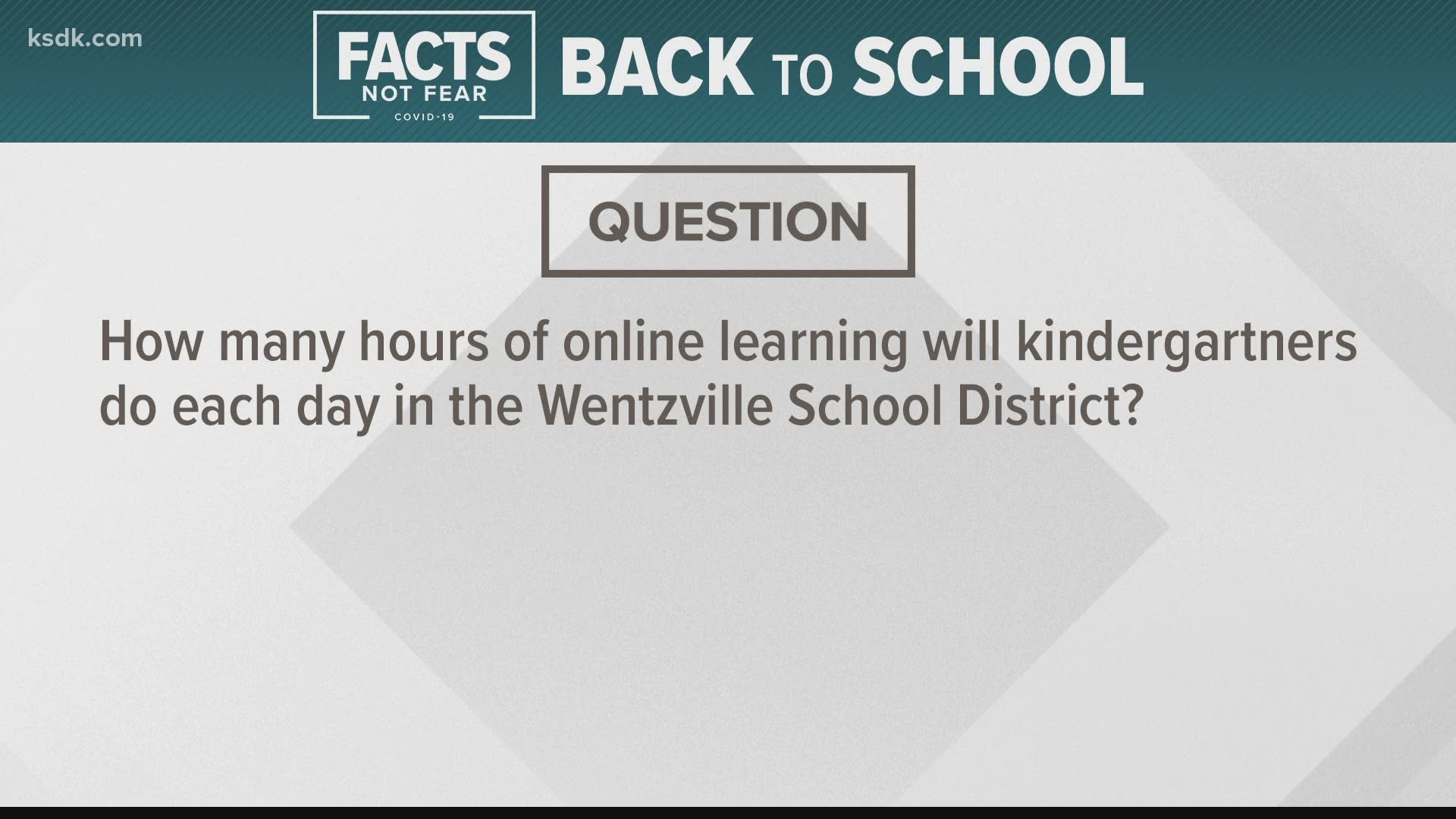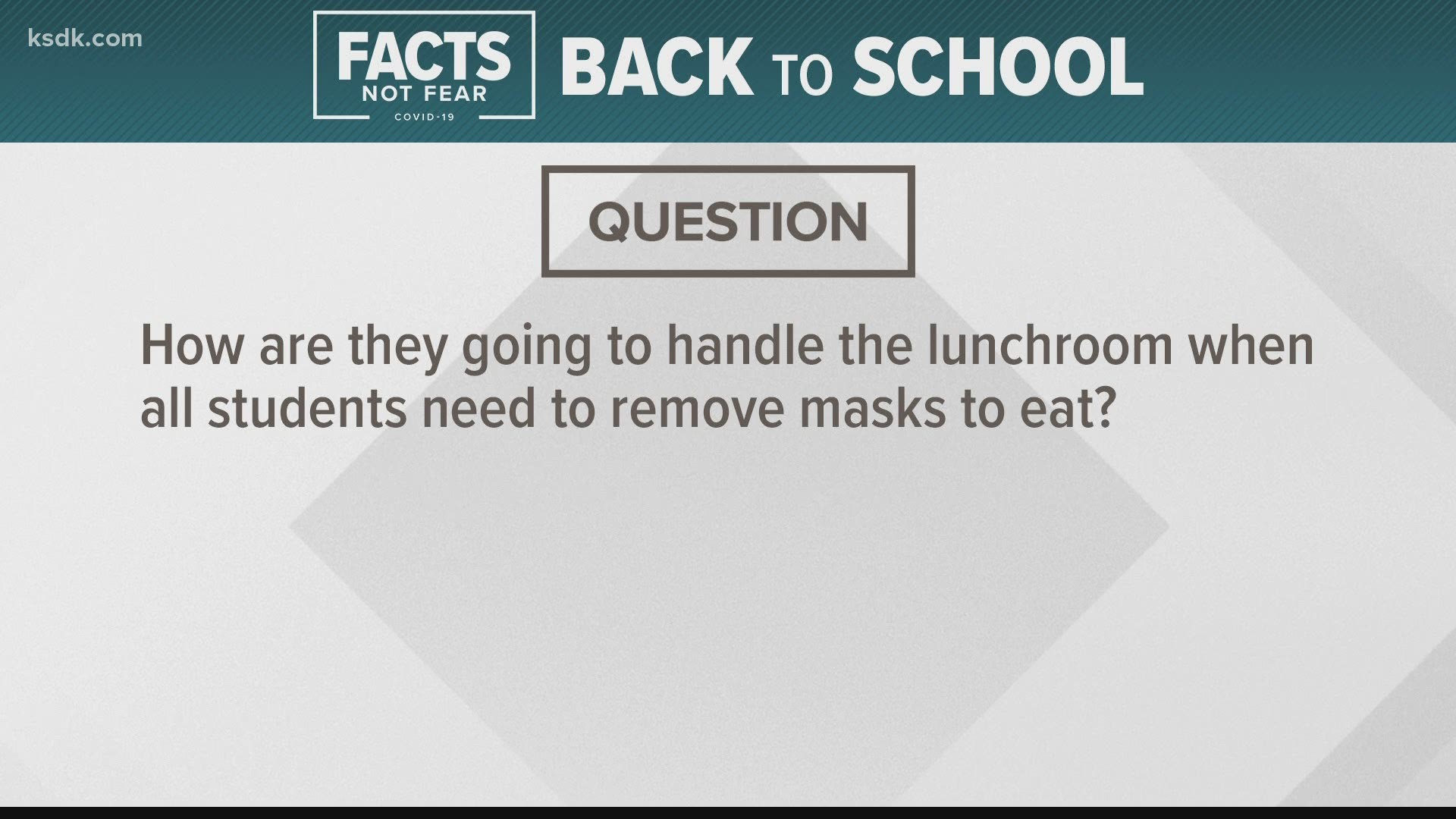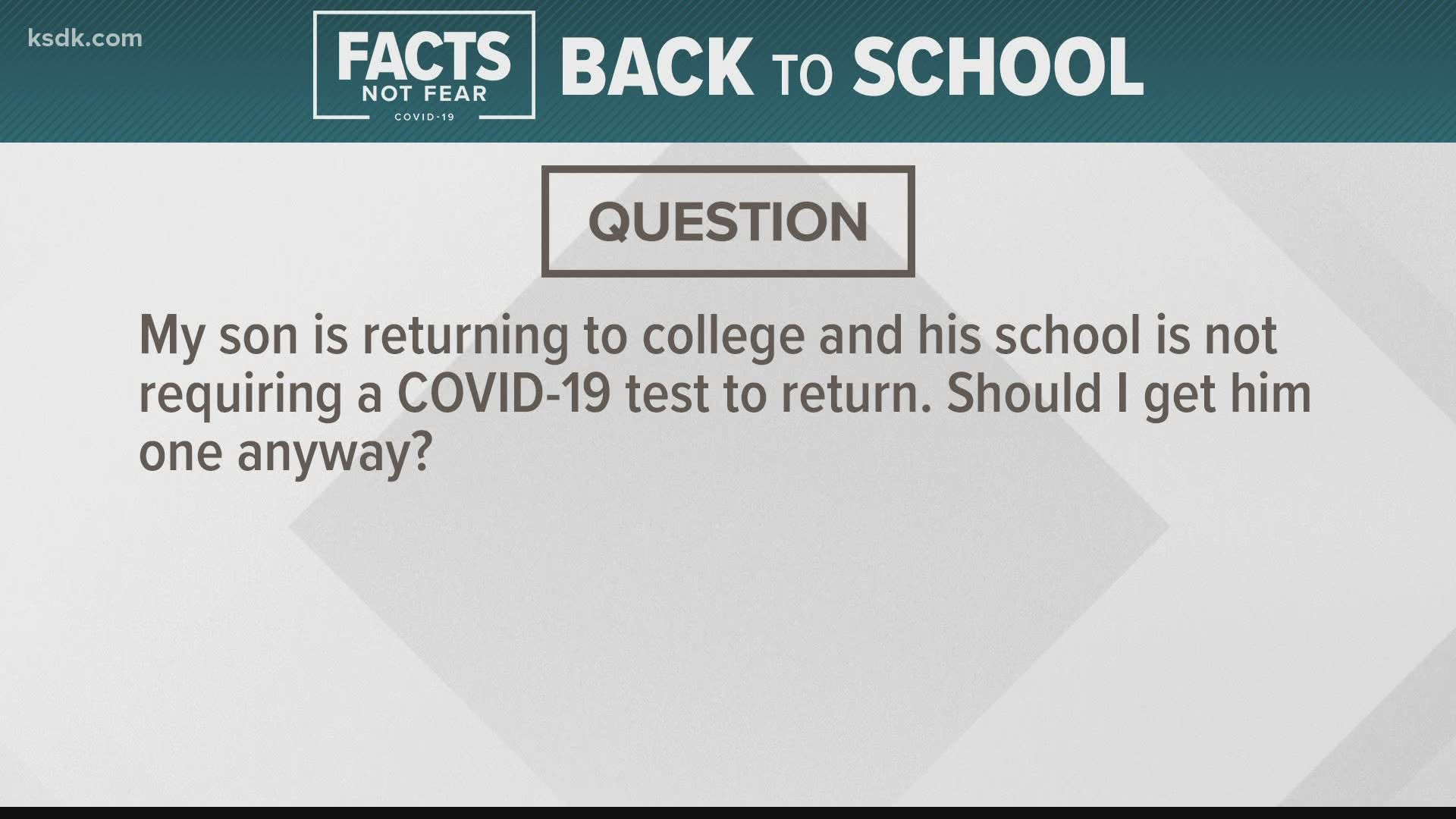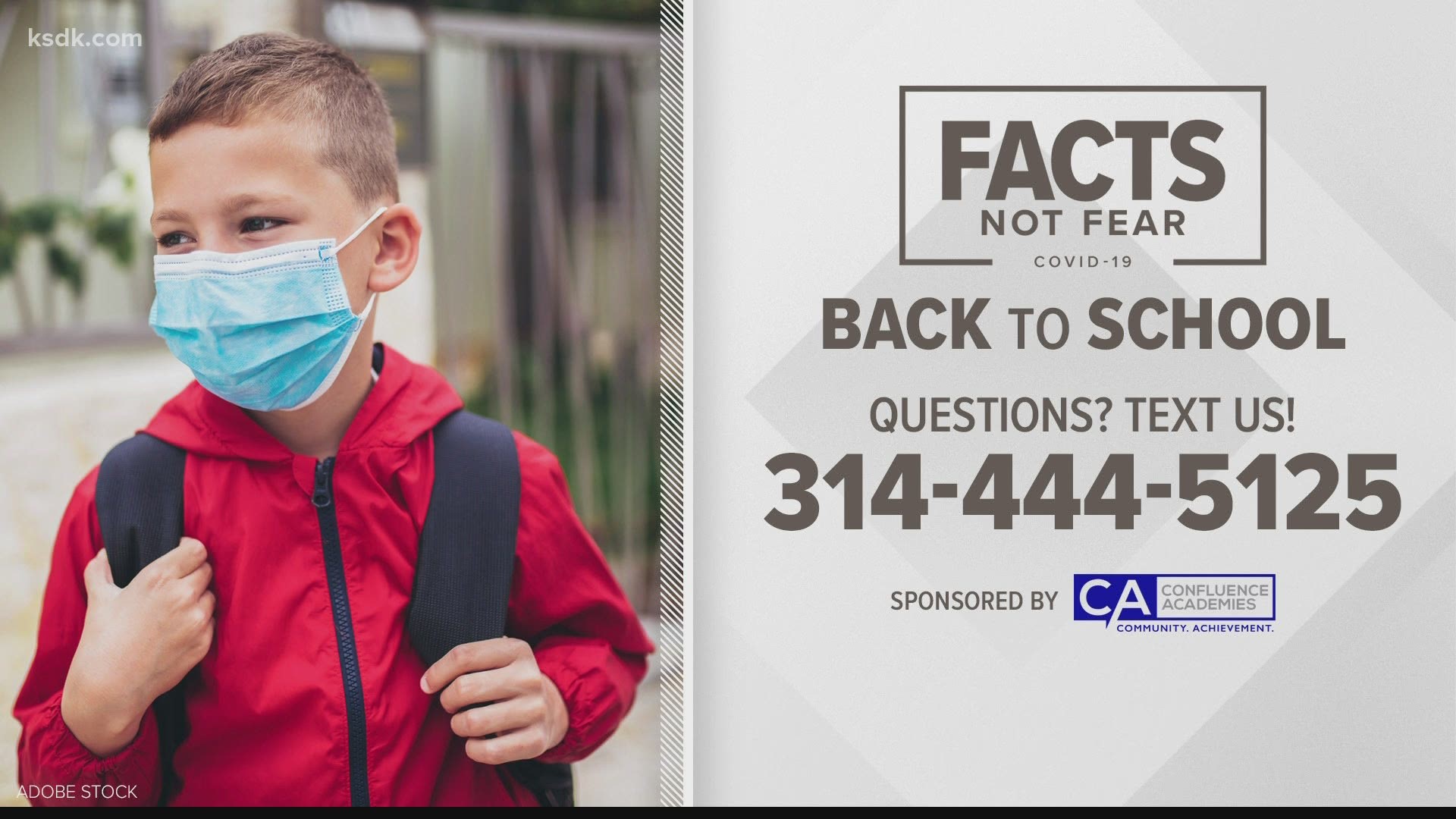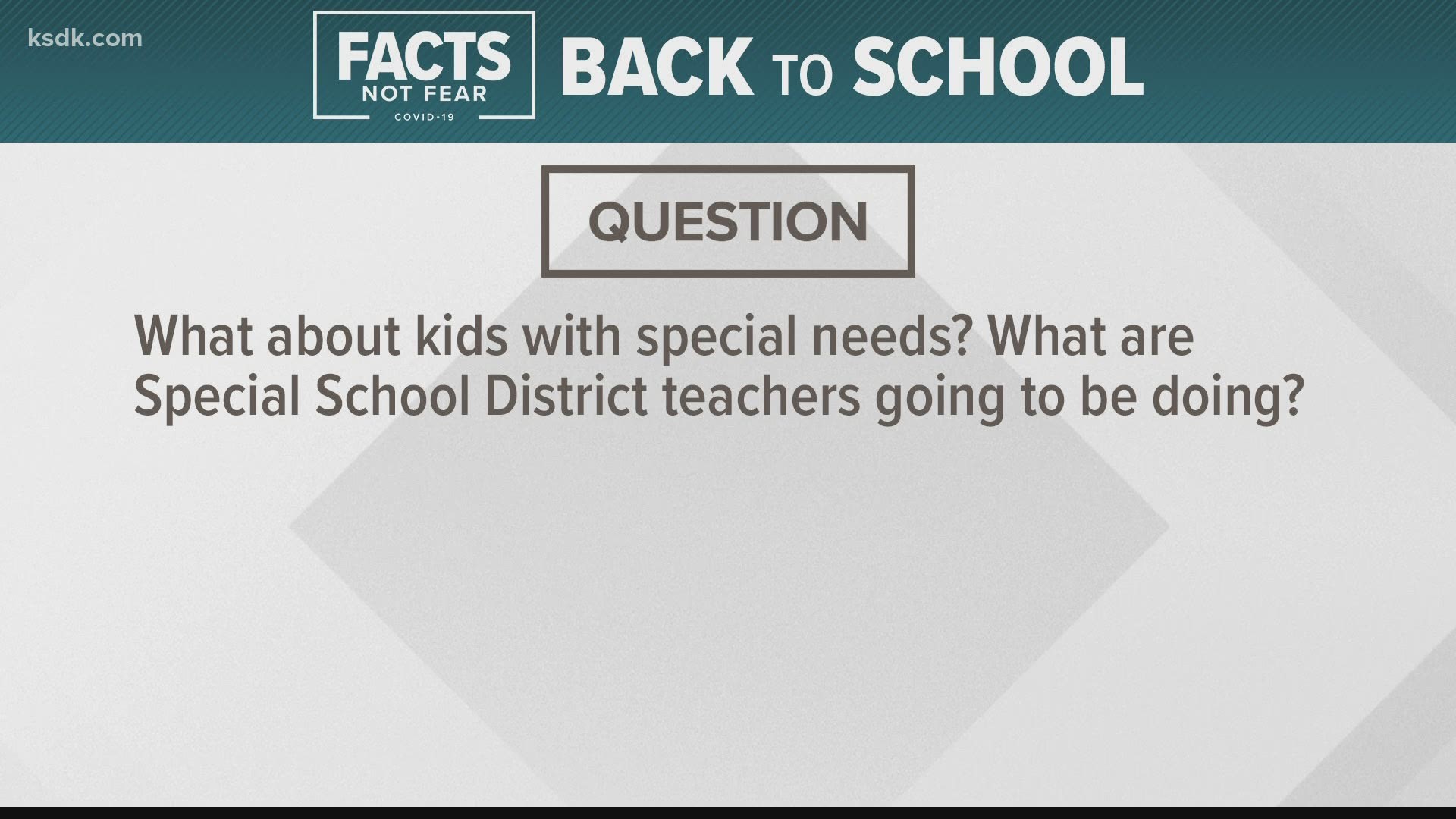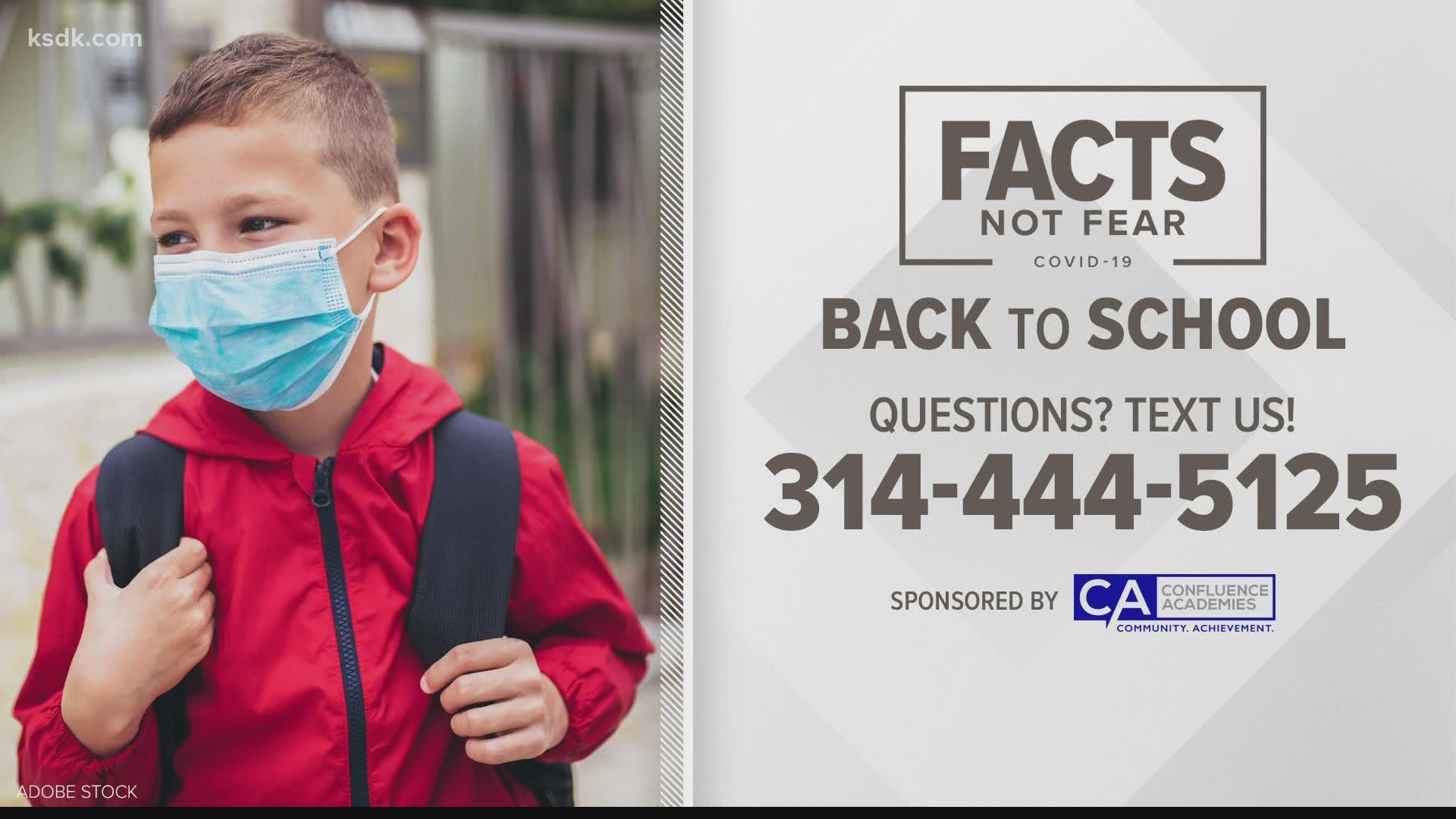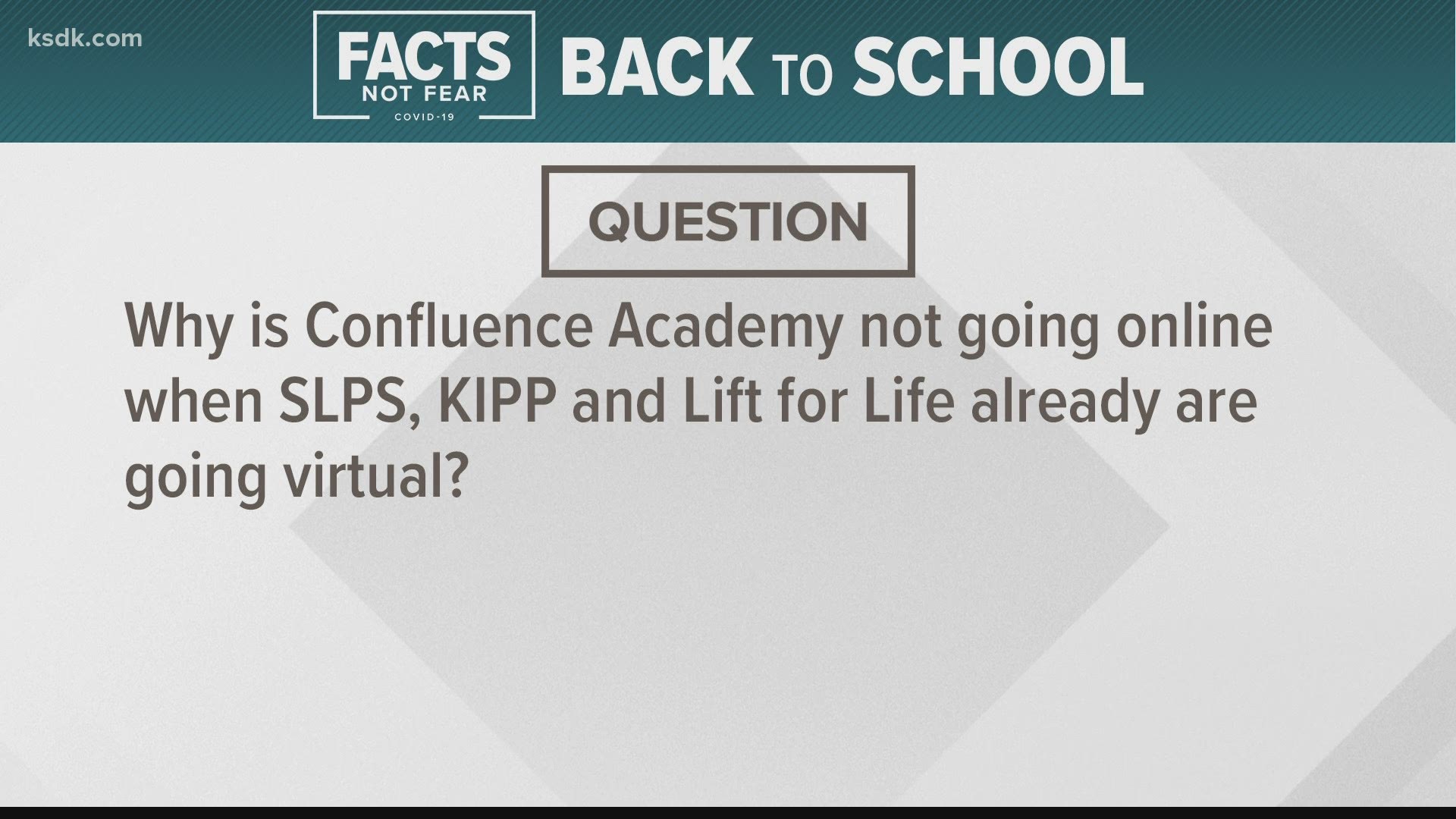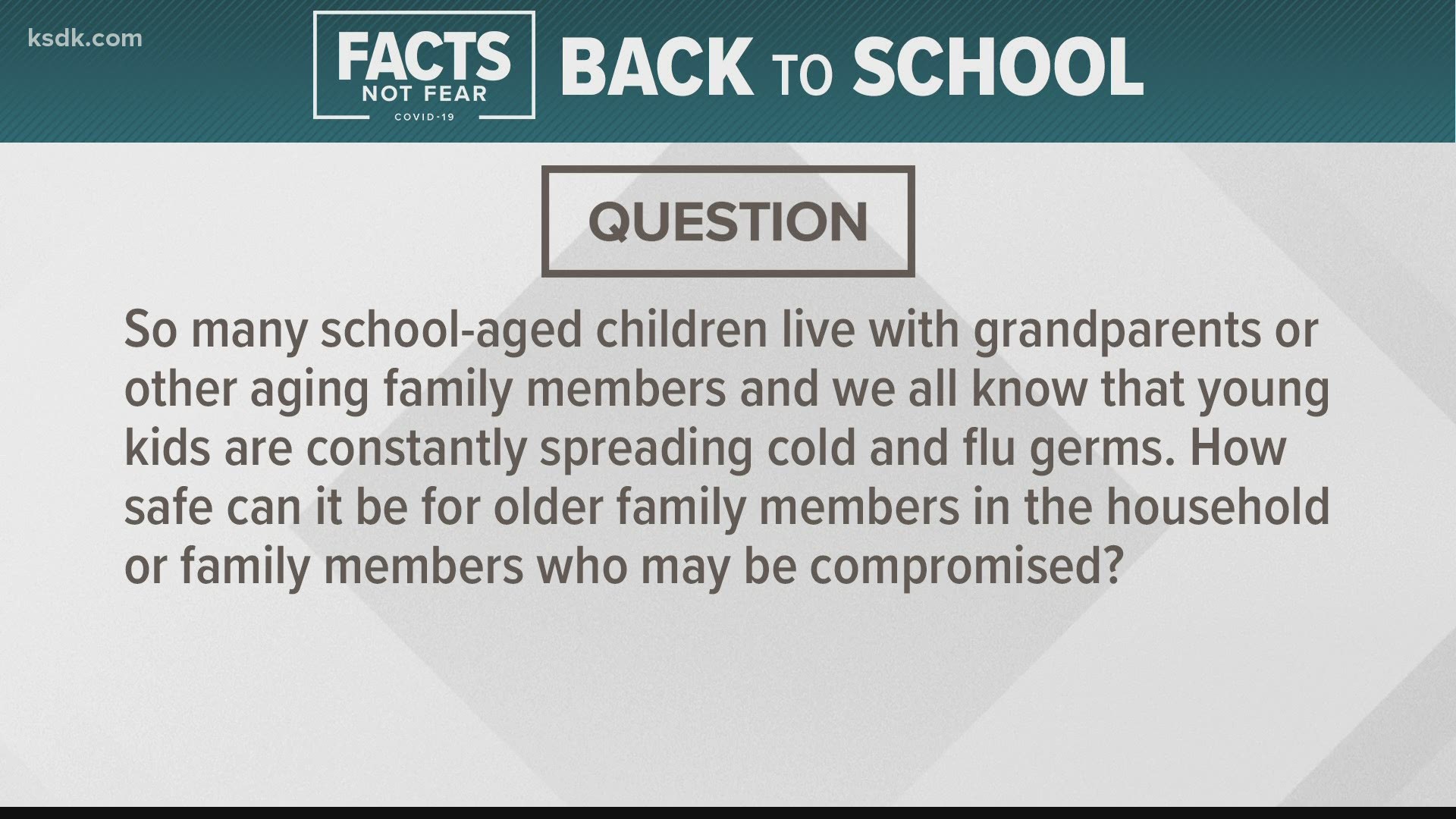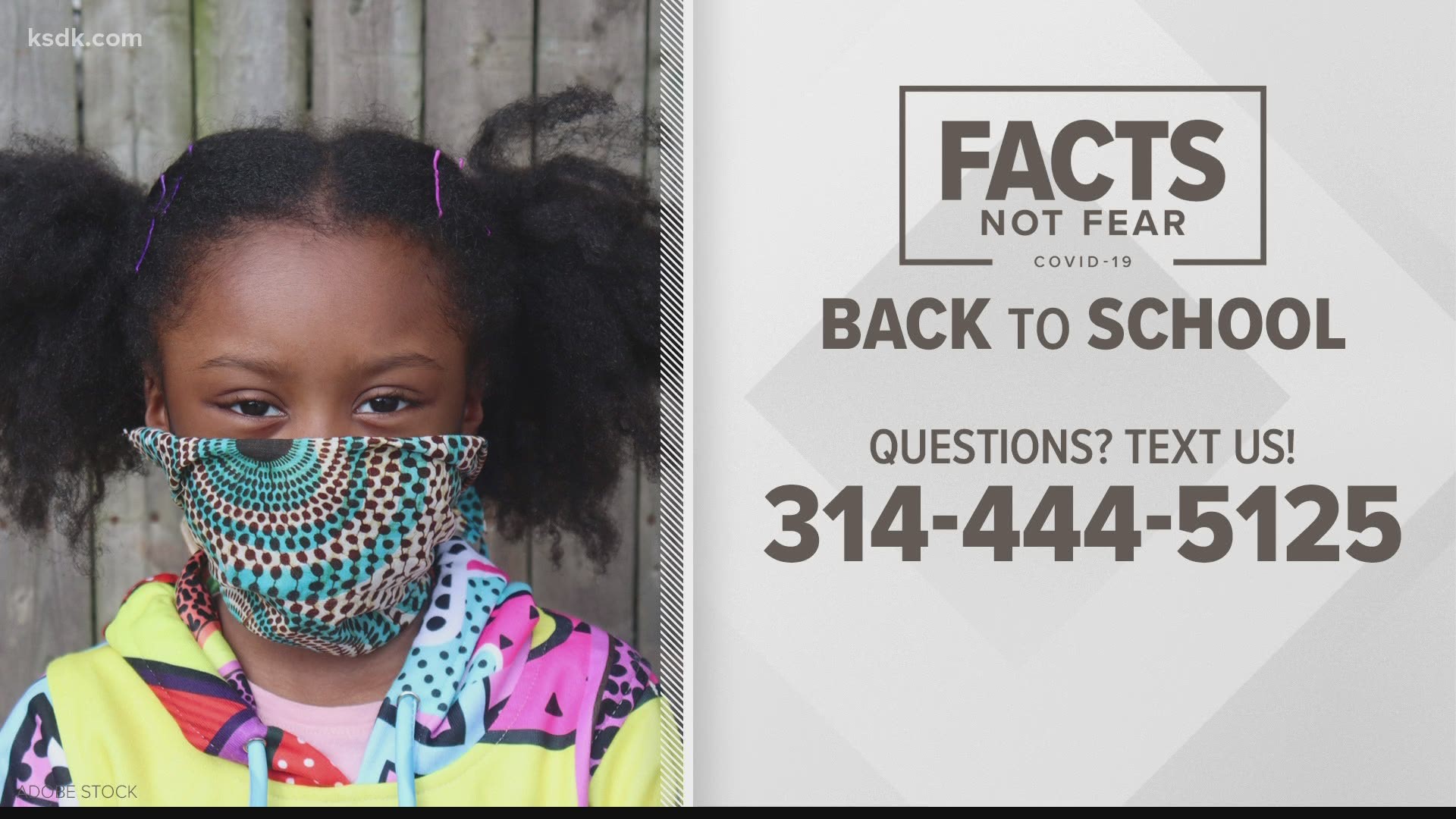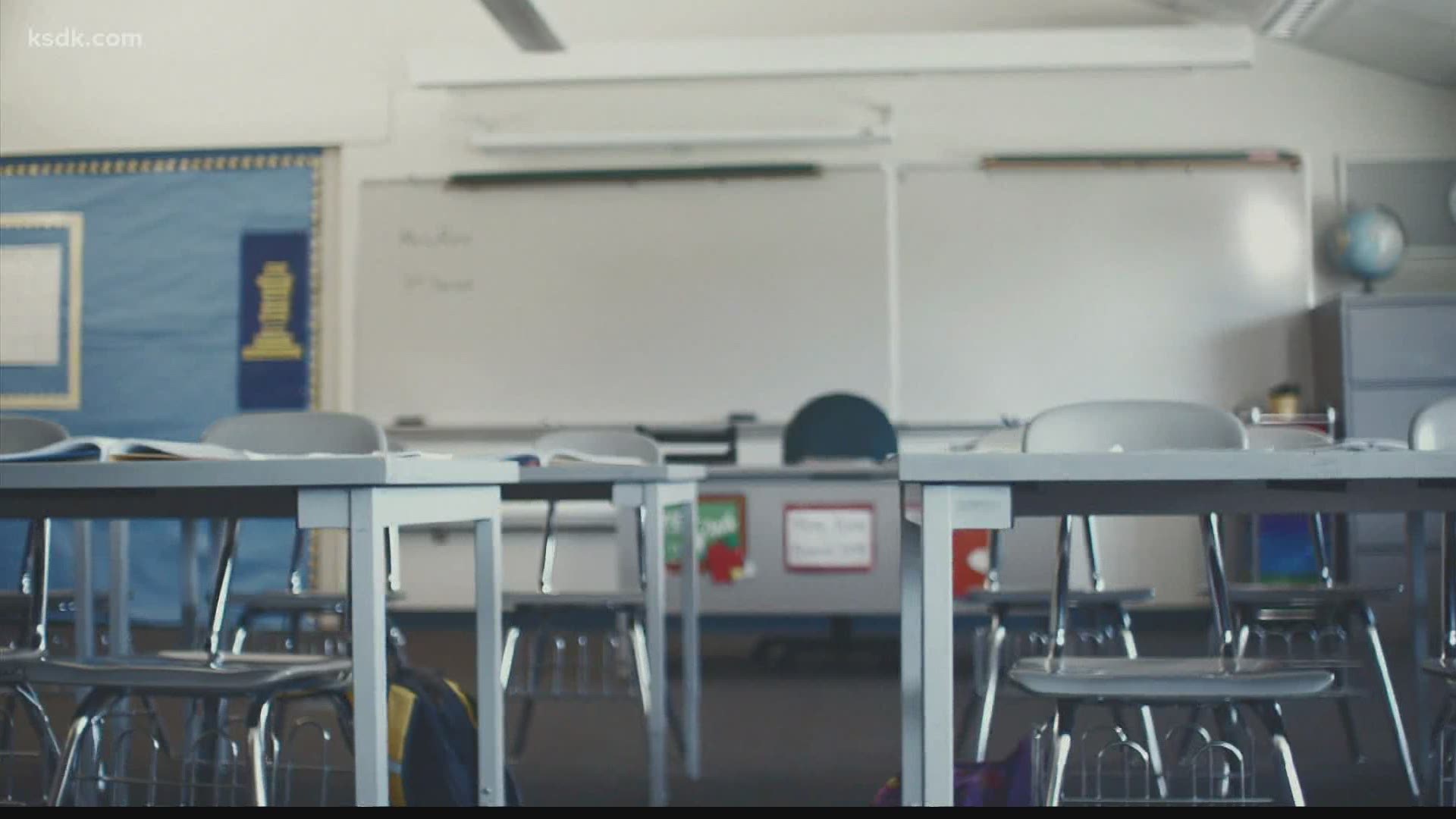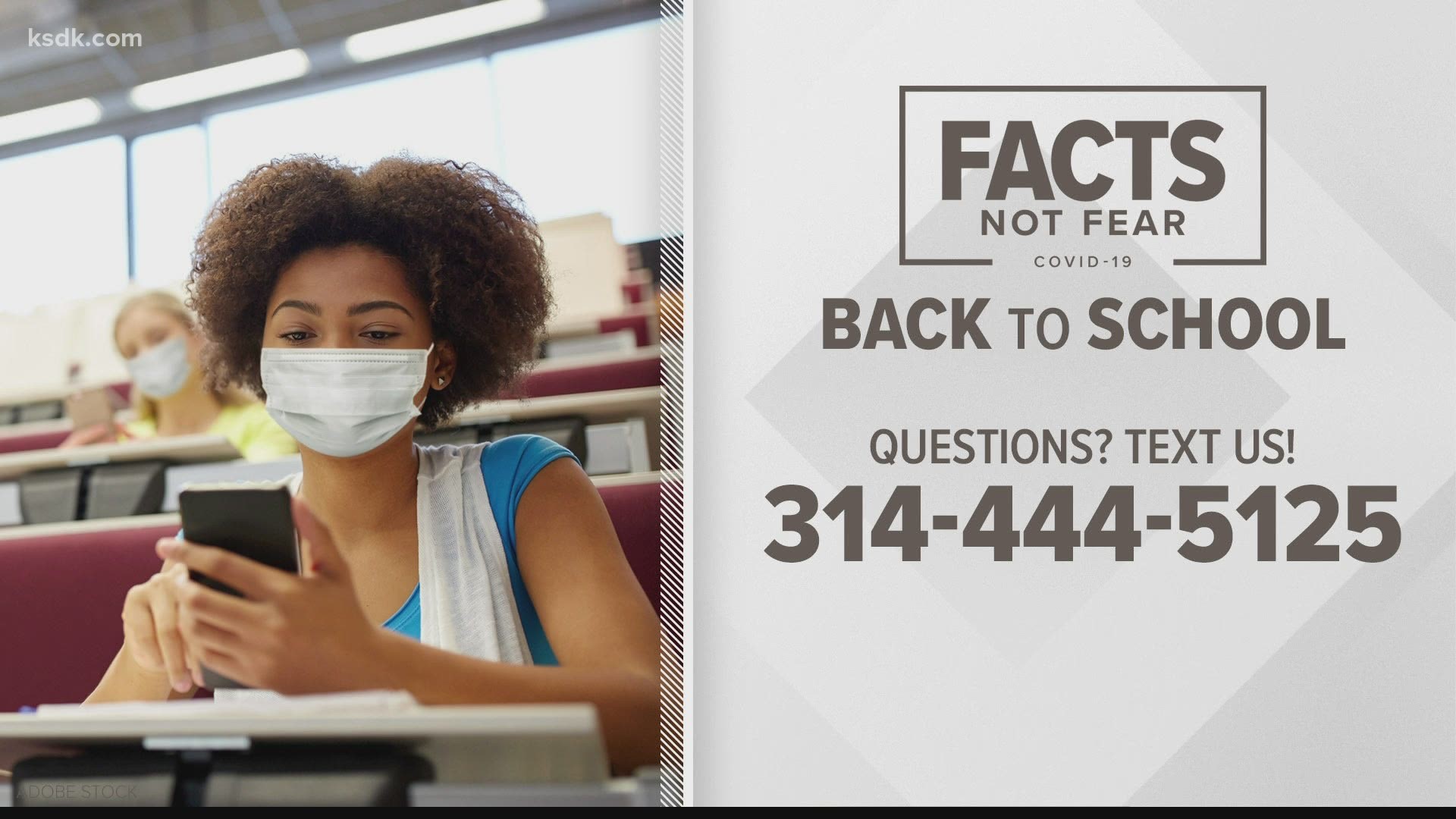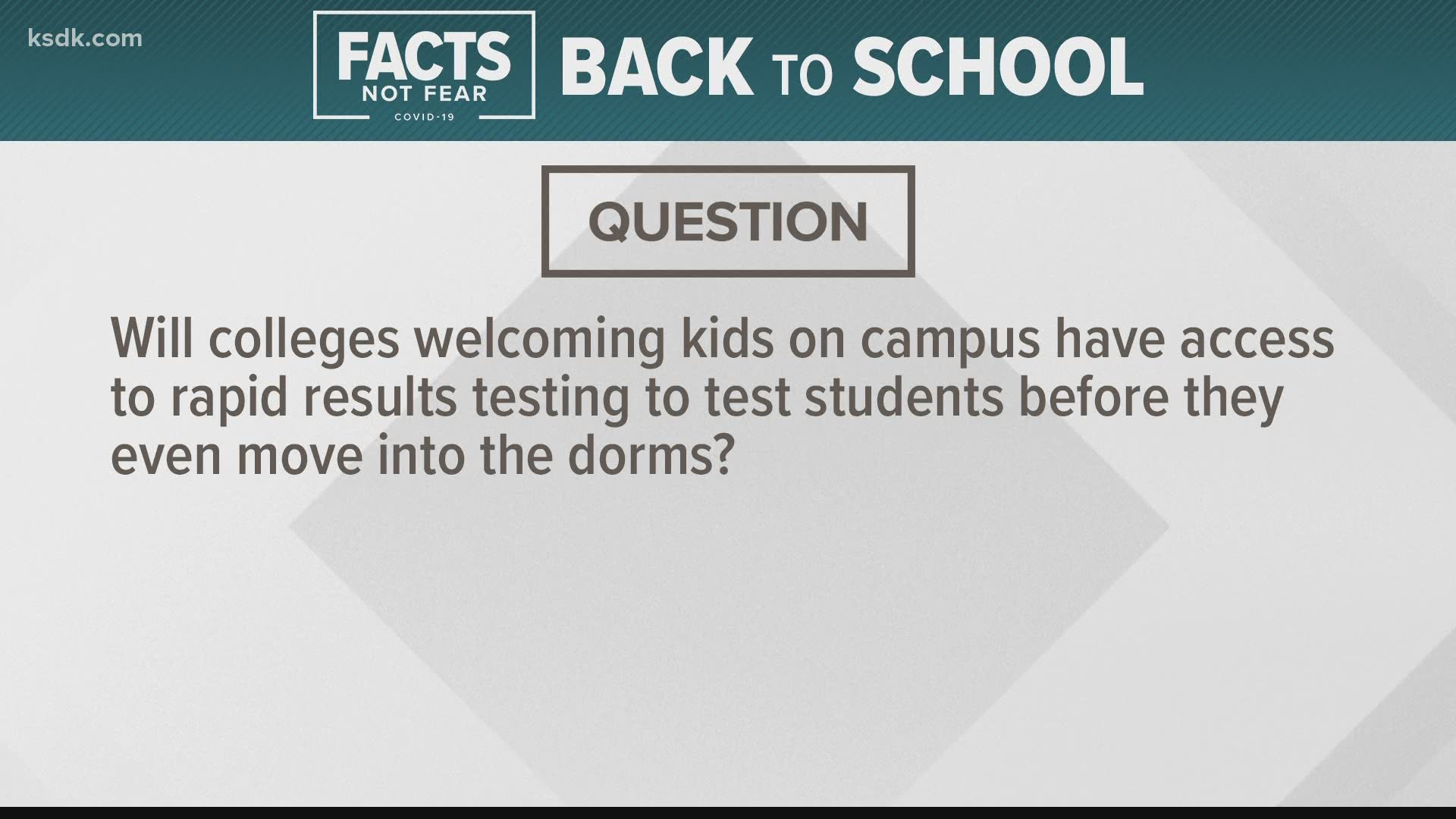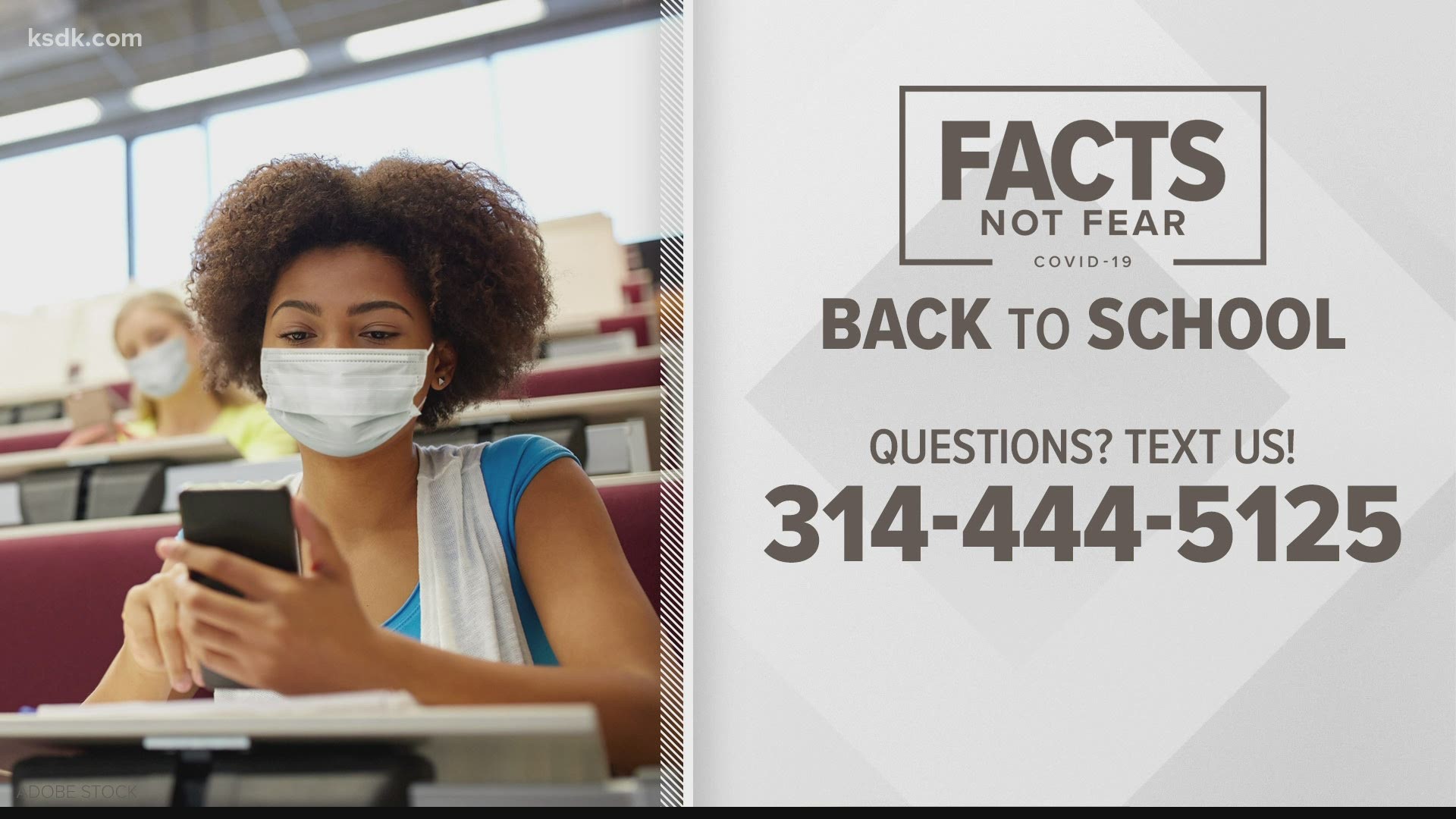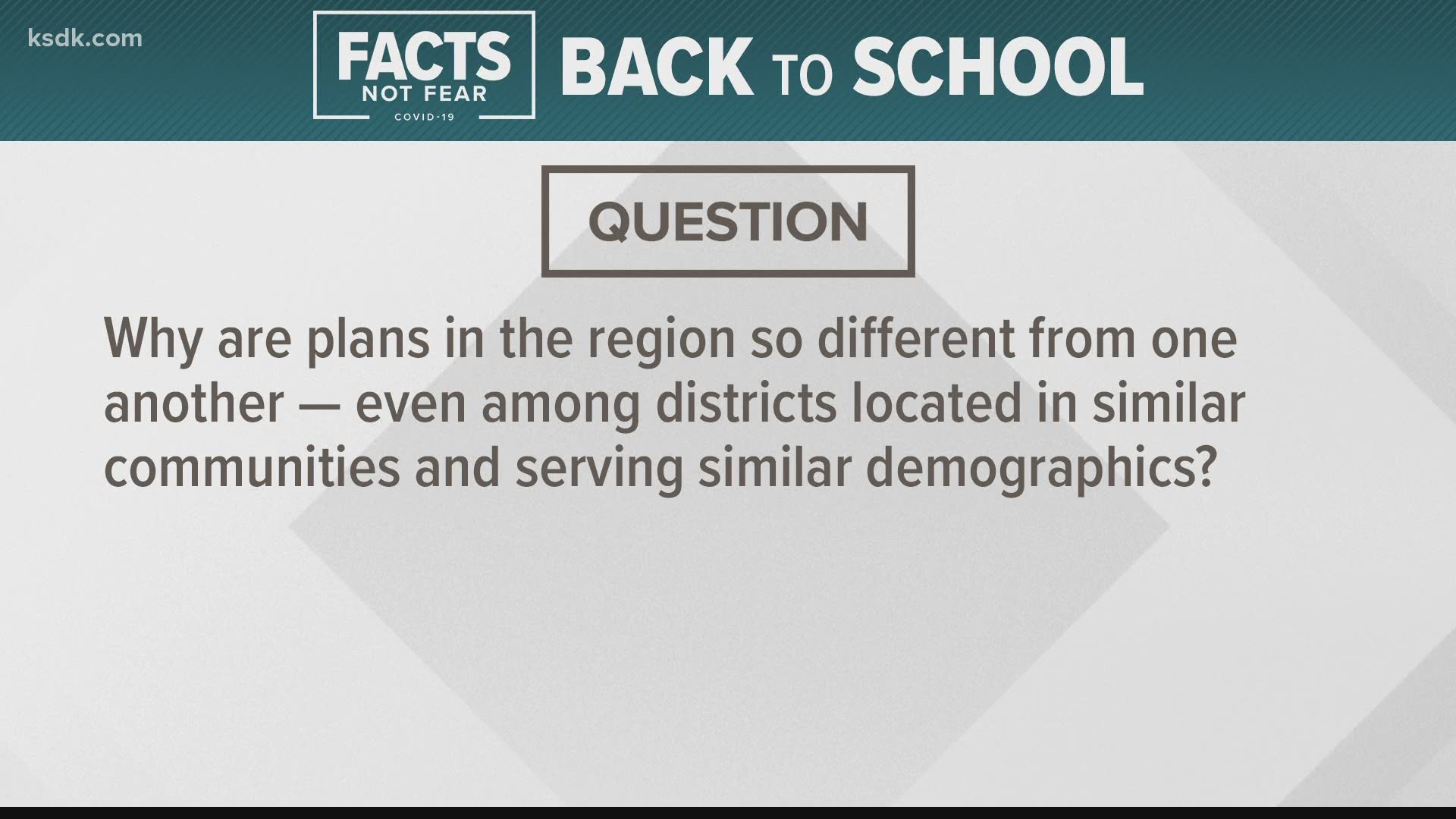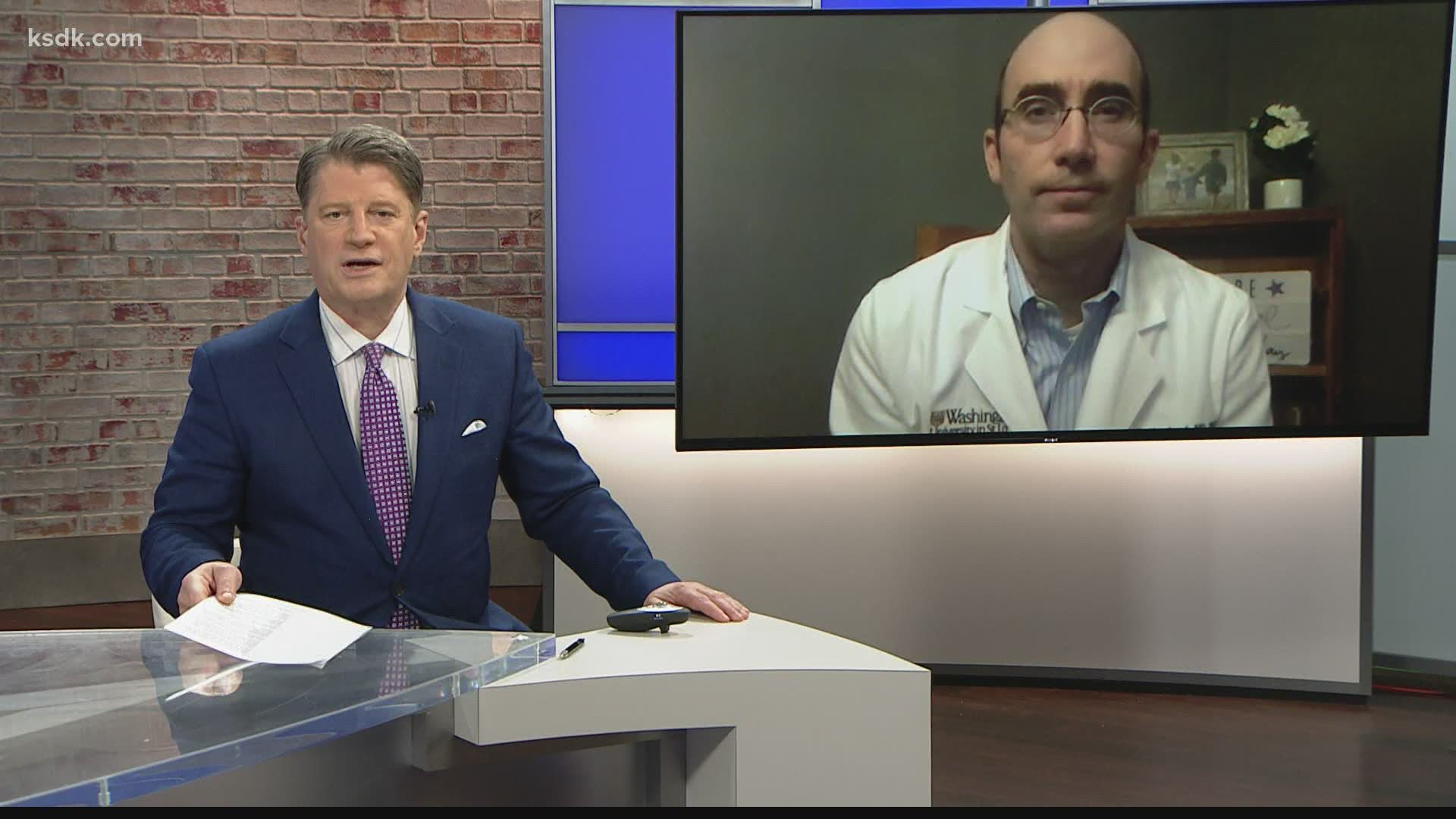ST. LOUIS — This school year will look unlike any other as districts and families make difficult decisions in the middle of the COVID-19 pandemic.
We know there is uncertainty as parents, students, educators and staff members prepare to return to school, however that may look.
That’s why 5 On Your Side is focusing on giving you facts and not spreading fear.
We are taking your questions and concerns straight to the experts. 5 On Your Side is partnering with EducationPlus to get your questions answered. Nearly 60 school districts throughout the St. Louis area are members of EducationPlus and it's led by local superintendents.
You can read the answers to the questions submitted below.
If you have a question, you can text us at 314-444-5125. This is a text-only line. Follow our latest COVID-19 coverage at KSDK.com/coronavirus and on the 5 On Your Side app.
Back-to-school coverage:
I'm an empty nester. How can I help a student or teacher? Are schools or boys/girls clubs looking for volunteers to help tutor kids?
Unfortunately, most school districts are not letting outside visitors inside school buildings to maintain safety measures for students and staff. However, contact the building leadership of your local school and ask if there are ways you can support their efforts or direct you to any local organizations who require additional assistance or reach out to neighbors and friends who have school age children and inquire how you might be of assistance. All families will struggle with the strains of this new school environment and would appreciate a helping hand.
I read that little children don't have to wear masks partly because their lungs are smaller and so their sneezes and coughs aren't as forceful. Is that true? If not, is the only reason they don't wear masks because they fidget too much with them?
All children can wear face coverings and it helps to model good mitigation strategies to prevent the spread of COVID-19. Younger children’s nasal passages have not developed the membrane necessary to spread the virus. However, we’re still discovering new information about COVID-19 so we should work to keep even the youngest safe by frequent hand washing, not interacting with large groups and using a face covering when possible.
My daughter is going to Hazelwood West Middle School. Do you know if they have any tutors for kids?
Most school districts are trying to add additional support for students’ academic needs, especially those in a virtual environment. Contact the building leadership at your child’s school for additional information about support services offered that can address your child’s needs.
Should children be tested every day they enter the school since after school who knows where these children go?
At this time, COVID-19 tests are not readily available to administer on a daily basis. School districts are asking staff and students to self-monitor daily for COVID-19-related symptoms. Most school districts are requiring this self-monitoring to be documented on a form before entering a school building.
What plans do districts have in place to handle mental health issues if a student, teacher, staff member or family member dies from contracting COVID-19 from a student who returned to school?
All school districts have mental health services available whenever someone in the school community passes away regardless if it is from COVID-19 or not.
Do we get extra food stamps in Missouri for our kids out of school?
All school districts are providing meals for students in need even though they are utilizing a virtual instruction platform. Check with your child’s school leadership to find additional information on services provided by your school district.
The schools are getting ready to open in the Metro East. Can you tell us if the governor imposes another shutdown, as he should, will the schools automatically close down? Should they open and have all that increased exposure if they are closing down in days anyway?
All school districts are implementing mitigation strategies such as face coverings, social distancing and minimizing interaction to ensure the safety of students and staff. Shutdown orders may not include school buildings depending on the scenarios identified that are increasing the spread of COVID-19. All school districts will work with local and state officials to determine the best course of action to keep students and staff safe and healthy.
We just took our daughter to Mizzou for the school year. If she (or her roommates) were to contract the virus, how do we safely bring her home without contracting it ourselves? Are masks and face shields enough? I have an autoimmune disease and I need to find a safe way to deal with this if the situation arises.
Using face coverings is important along with practicing as much social distancing as possible. Ensure that you use face coverings when in a car. Once you are home, try to identify separate spaces so that you can maintain as much social distancing as possible. Also, frequently wash hands and disinfect high touch areas.
How would large schools, or any school for that matter, ensure social distancing in hallways and during class changing?
Face coverings should be worn by all students when social distancing is not possible. Some schools may designate different entry points for a school building and designate hallways one direction only to minimize student interaction in high-traffic areas. School districts are instituting parameters within their school buildings to ensure the safety of students and staff.
How will school nurse procedures be different when students are back in school?
School nurses are accustomed to working with students who are sick, so they already have implemented stringent safety protocols. School nurses will most likely have a face shield in addition to using a face covering; will utilize gloves when working with a sick student and will need a separate space to isolate a sick student until a parent/guardian can retrieve the student from school.
Should in-person schools let employees/teachers know if there is a positive case of COVID-19 within the school setting?
As part of contact tracing efforts, schools will inform staff and students when they have come in close proximity to a COVID-19 positive individual.
Why don't they keep the children at their desk and move the teachers from classrooms?
Many schools will be implementing a process of having students remain in one classroom and have the teachers move to minimize interaction. COVID-19 mitigation strategies may vary from school to school depending on the environment but all schools are implement protocols to ensure the safety of students and staff.
I keep seeing on the news how a football player/staff member/coach has tested positive and they make the public very aware of the positive test. I am very concerned my school district is not taking those precautions.
Most school districts work with their local county health department to track and communicate about positive COVD-19 cases. If you’re concerned about communication, contact the central office of your school district and inquire what the policy is for reporting COVID-19 cases.
Is there a law that requires you to report an outbreak/exposure to school district employees, staff, and families? And if not, what does that mean if they get exposed, sick and die? As a school, we send home a letter to every parent in a school when a child has ring worm or the flu. What is the law on COVID outbreaks and reporting them to the public?
COVID-19 is still a relatively new scenario and therefore there have not been any specific laws enacted around COVID-19. Testing sites are required to report COVID-19 positive tests to the local health department. As part of contact tracing efforts, the health department will contact school officials and the school will in turn contact staff and students who have been in close proximity of the COVID-19 positive individual.
What's the penalty for keeping your kid out of school for two weeks after it starts just to see what happens with the pandemic?
If you are concerned about sending your child to school, all schools are offering a virtual option for educating students. This option may be best for your families’ concerns.
What are teachers that have children in a different district supposed to do if the teachers have to be in school and children are doing virtual learning from home?
Most school districts are trying to put in additional support for staff and students knowing that a virtual learning environment places an extra burden on families. Check with both the school district that employs you and the building leadership of your children’s schools to find specific information around provided services that can help with your situation.
I am a grandmother who lives next door to her two high school grandchildren. When school starts, one will go to a full week of face-to-face instruction plus soccer club. The other grandchild will attend a high school with a hybrid plan that includes two days on campus. Can I still visit their family safely in their home and can they visit in my home? We all wear masks in public, social distance and frequently wash our hands. I typically social distance from them while in the house. Shared meals are in my sun porch with the windows open and ceiling fans on.
If you continue to practice social distancing and visit outside, you will be implementing the recommended safety measures. If you can’t practice social distancing of at least 6 feet or are inside, also use a face covering for added protection. Also, please ensure that you and your grandchildren thoroughly wash your hands before and after visits.
How do you disinfect a book?
It would be very difficult to disinfect a book. However, individuals can disinfect their hands before and after using a book which will help to ensure safety.
I'm a teacher. Should I wear a face shield and mask or is one of those things safe? I also wear glasses. Will an air purifier help at all if I get one big enough to clean the air in my room five times per hour?
A face mask or covering that is worn properly should be sufficient protection. There have not been any conclusive scientific studies to show that an air purifier helps with mitigating the spread of COVID-19. However, it can only help improve the overall air quality of your classroom.
My niece takes medications for cancer. Is it safe for her and other kids like her to start school?
Your niece should consult with her physician. Her personal doctor can recommend the best course of action and what additional mitigation strategies she should implement when in settings with other students or individuals.
It is obviously not practical to disinfect every page of a book. How long until the book can be used by a different person?
Strategies should be in place to ensure that an individual disinfects one’s hands before using a book and then again after using the book. Transmission from an object is unlikely unless someone touches an infected service and then touches their mouth, nose or eyes before disinfection or washing their hands. By enforcing a protocol of disinfection of hands before using books and being extra careful not to touch one’s face while using a book, books can be utilized by different people without enforcing a wait time.
What is the logic that Northwest R-1 has now decided a hybrid plan for middle school and high school children due to an increase in cases of COVID-19 in Jefferson County yet no concern for children K-5, who go to school five days a week instead of hybrid? Why would you not do the same for all children?
Recommended COVID-19 mitigation strategies include implementing social distancing and keeping students within small consistent groups throughout the day to limit exposure. These strategies are often easier to implement with lower grades than with older students. Younger students can have a more difficult time learning virtually, so getting (or keeping) younger grades in the classroom will remain a priority for all school districts.
How can I get internet for my child's laptop for school? I don’t have the money to get internet at home.
Most school districts are trying to provide Wi-Fi access to all families in need. Contact the leadership of your child’s school building to find out more information on the support offered by your school district.
If masks work, why can't our children be in their classroom with other children wearing a mask and a teacher who is wearing a mask?
Implementing proper protocols such as wearing a mask are only one consideration when determining if it is appropriate to bring students back to face-to-face instruction. Additional protocols required to ensure the safety of students and staff include social distancing and limiting the number of students within a classroom. Educational leaders also monitor community infection and transmission rates. If community transmission and positivity rates are high or are rising it may be inappropriate to bring large groups of people together regardless of mitigating strategies. Many school districts are unable to effectively implement all of these protocols and/or community transmission rates remain high; therefore, school leaders have elected for a virtual learning platform to ensure the safety of students and staff.
Please look into how students with disabilities receive their service and support by virtual classes. Hundreds are required to have job transition support (job training) that cannot be taught over the internet, neither can speech therapy and physical therapy. It appears these students are being forgotten.
School districts are trying to establish support systems and protocols to ensure they are meeting the needs of all students especially those with disabilities. Those systems will vary from district to district. However, some helpful information for parents and students can be found on the Special School District website. While the Special School District only serves students in St. Louis County, the resources found on its website can be helpful for all students.
How many hours of online learning is in a day for kindergartners in the Wentzville School District?
Online learning for kindergartners will vary from district to district. It is important for parents to remember that while students may attend school for 7 or 8 hours a day, that entire time is not spent engaged in learning. A typical student day has a significant amount of non-academic time including lunch, recess, bathroom breaks and transition time between academic areas. Contact your child’s school directly to find out additional details specific for your child’s learning needs.
I'm 69 years old and work at a school as a preschool teacher part-time. Would you advise me not to take the chance of working in a school?
That decision should be made in consultation with your personal physician, who is aware of both your age and any other potential risk factors that may apply to your situation. In making this determination, you should also consult with your building principal or the human resources department in your school or district to learn more about medical leave policies. Regardless of any one’s current health conditions, one should be diligent in practicing social distancing, wearing a mask and maintaining good hand hygiene.
Are charter schools going virtual all year long?
Most charter schools have only announced virtual learning for the first portion of the school year and will continue to evaluate transmission data to determine when a face-to-face learning environment can be implemented.
If your school district has had all day daycare/day camp this summer, why can't the school go back to all day five days a week?
School districts were able to limit the number of children participating in summer daycare/day camps. Additionally, some of these camps were held outside which does not require as strict of protocols as when moving inside school buildings. Most schools could not effectively implement limited class sizes, mandatory face masks and social distancing and still serve all the students within their district. School districts needed to move to a virtual learning platform to ensure they were providing instruction to all students.
Every school district in the Metro East offered a different reason for going virtual, one of them being that cases are rising among children. However, I can find no evidence of such claim. The St. Clair County Health Department provides very vague information with the closest being people user 40 are getting sick.
The health and safety of students and staff is of utmost importance in all school districts. Dealing with COVID-19 is a new challenge for school leaders and many have relied on information from health department officials and doctors to make the best decisions. School leaders must balance the benefits of in-person learning with the risks to the community associated with COVID-19. When faced with decisions potentially impacting the health and safety of students and staff, school leaders must take an approach that has the best potential for positive outcomes for students and their families. For this reason, many school districts have chosen virtual learning to start the school year.
What advice is there for working families who cannot afford in-home childcare or private school?
School districts recognize the added stress and difficulty that a virtual learning platform places on their school families. Each school district is developing their own system of additional support to help families who are struggling with the current environment, including child care options, support centers and additional tutoring services. Please contact the building leadership team of your student’s school to find out what additional services your school district is providing to their families. Also, please note that the CARES Act expansion outlined eligibility for families to take 12 weeks of paid leave under the Family and Medical Leave Act to help those who are adjusting to remote learning.
What are St. Louis public schools doing about getting hotspots and computers or iPads to the students? Will Chromebooks be provided for every student instead of just one per family? How can kids learn or do their work on time?
Every district in the region has spent significant time and resources to ensure that students have access to a virtual instructional platform. Each district started in a different situation and therefore has its own set of challenges. School districts are trying to provide computers for every student and access to Wi-Fi for all families. For answers to questions specific to a school or district, it is best to contact your child’s school directly.
Will money be allocated for students’ parents for lunches or books?
At this time, we are not aware of any financial allocations directly to students’ parents. However, most school districts are providing meals for students, computers and Wi-Fi access if necessary. Check with your local school district for additional information regarding these services.
Why are the St. Charles schools choosing to have classes five full days (except Wentzville)? Aren't they worried about transmission rates like the St. Louis County schools?
The data on transmission rates, positives cases, etc. varies from community to community, and even among areas in the same community or adjoining communities. School leaders are closely tracking data for communities in their school district in making determinations of whether or not school will be face-to-face or virtual. Whenever face-to-face instruction is an option, other protocols have been put in place, such as social distancing, reduced class size, increased sanitization frequency and wearing a face covering when social distancing is not possible. All school districts are providing a virtual option for students whose families would prefer that for their children. The safety and well-being of all students and staff has been the driving force around any decision made by a school district.
What are the schools saying they will do if 10+ people get COVID-19? Will the whole school go virtual?
Local health agencies will work with school districts to establish protocols in response to any reported cases. Anyone who has tested positive for COVID-19, including anyone who has been in close contact with that individual, will have to quarantine for 14 days. Depending on where those cases are reported within a school building — for example all in one classroom versus throughout the building — will determine if the entire school will have to close. For additional information on how St. Louis County is approaching contact tracing, please see the algorithm developed by Washington University.
If someone tests positive when schools open, what will be the protocol that will be in place? Especially if a family has kids in multiple buildings, like in elementary and middle school.
Local health agencies will work with school districts to establish protocols in response to any reported cases. In general, though, according to the CDC guidelines, anyone who has tested positive with COVID-19 will be required to quarantine for at least 14 days. Anyone who has been in close contact with that individual will also have to quarantine and monitor for symptoms. In most cases, close contact would include family members.
St. Charles County schools are going back to school in person. Does St. Charles County meet the positivity rates as outlined by CDC for back to school?
There have not been specific metrics established for when a school should utilize a virtual or face-to-face instructional model. States that have developed criteria vary widely. Medical professionals have stressed there is not one particular metric that is conclusive to the determination of method of instruction, but instead have suggested many factors that should be considered. School districts have been working closely with local health departments to ensure the safety of students and staff if returning to a face-to-face instruction scenario.
How are they going to handle the lunchroom when all need to remove masks to eat?
Social distancing will be required if students are eating within a cafeteria setting. If social distancing cannot be implemented, students will most likely eat within their respective classroom to limit the student interaction.
With the new restrictions in the Metro East in Illinois, how does this effect schools? Some, but not all, have gone remote. It says gatherings are limited to 25 people or 25% of capacity. Does this not effect schools and reopening plans?
Gathering limitations set by local health agencies generally do not apply to school buildings. However, school districts are monitoring transmission data and working with local health agencies and officials to determine the safety parameters necessary for opening school buildings and conducting school activities.
Ferguson-Florissant parent here, from what I've been told, the school expects kindergarteners to be logged into their Chromebook participating in lessons all day. How does the district think this is possible when parents work and daycare or sitters can't focus on helping them learn while in their care? And how is this healthy for their minds or eyes?
School districts are aware that each grade and age level has different requirements especially when it comes to virtual learning. School districts are working to ensure the proper amount of time is spent learning online, doing activities offline and taking breaks from school activities. Contact the Ferguson Florissant Early Childhood Center at 314-824-2074 for additional support and information.
My question for the school is how a single working parent who is an essential worker, who has no family around, who also cannot afford child care supposed to do this? Also, the low-income families who can't afford computers for all their children. How are they supposed to do this?
Most school districts are trying to provide additional support for families in need, including computers and Wi-Fi access for all students, childcare options, support centers and additional tutoring services. Please contact the building leadership team of your student’s school to find out what additional services your school district is providing to their families.
My son's high school will have each student disinfect their desk before they leave. They have five minutes to get to their next class. I am concerned five minutes is not enough time for the disinfectant to work. What do you think? Would you recommend gloves or hand sanitizer before disinfecting?
Hopefully, your specific school will allow enough time in between classes to ensure that desks can be disinfected before departing to the next space. Schools are placing a huge priority on keeping spaces clean and disinfected. Gloves are not necessary when disinfecting the school desk; however, using hand sanitizer before and after disinfecting the desk would be recommended.
Can COVID-19 be transmitted from student school supplies when brought to school? Can COVID-19 be transmitted from student books and papers?
According to the Centers for Disease Control (CDC), current evidence suggests that SARS-CoV-2 may remain viable for hours to days on surfaces made from a variety of materials. When possible, cleaning of visibly dirty surfaces followed by disinfection is a best practice measure for prevention of COVID-19. Transmission is most likely to occur when a person touches an infected item and then touches their nose, mouth or eyes. The best practice is to disinfect hands before and after touching any surfaces that may be contaminated.
With virtual learning, how will it work if I have four kids under high school age and only one computer?
School districts are working to provide every student access to a computer. Contact the building leadership of your students’ school buildings to inquire about additional support and access to computers.
Where can I find the actual scientific data used to make the decision to keep kids out of the classroom? Relevant data of cases and hospitalizations/deaths of individuals from age 5 to age 18. I have never seen scary numbers in this age range to warrant the decision.
Area school districts have been utilizing data provided by local health departments to make decisions regarding the return to school to ensure the safety of students, staff and school families. Cases in our area continue to rise and until this number stabilizes and begins to decline, schools will continue to prioritize the safety and health of everyone involved with schools — students and staff.
My son is returning to college and his school is not requiring a COVID-19 test to return. Should I get him one anyway?
Unless your son has shown symptoms of COVID-19 or has been in close contact with someone who has tested positive for COVID-19, it is not necessary for him to get a COVID-19 test. As your son returns to school, remind him to self-monitor for symptoms, use a face covering, disinfect when necessary and frequently wash his hands.
I have my 16-year-old son going to school online. I'd like to know what Northwest High or the district is going to do for students who don’t have any kind of internet access?
Most school districts are trying to provide access to Wi-Fi for all students. Contact the building leadership of your student’s school to inquire about additional support.
I am a single mother of two kids ages 6 and 9 and now their school is going virtual. We live in Illinois. How am I supposed to go to work to provide for them? I feel their education is being negatively impacted because I'm not a school teacher and now can lose my job because of this decision. I am overwhelmed and this is causing many life challenges for our family and I'm sure I'm not alone, but what are we supposed to do? Why can't the school have some information for us if they are making these decisions?
School districts recognize the added stress and difficulty that a virtual learning platform places on their school families. Each school district is developing their own system of additional support to help families who are struggling with the current environment. Contact the building leadership of the schools your children will attend to find out about the specific supports in place.
When schools start, like the Catholic schools, are the fire departments willing and prepared to go into those schools for fire drills and fire inspections?
Emergency personnel are prepared to enter the homes and buildings within their communities when necessary. Personnel will have face coverings and the proper protective equipment to ensure everyone’s safety when entering a school, commercial building and/or home.
Why does St. Louis not just cancel school for the next year? Hold off and return when COVID-19 is under control!
Because of the increase in COVID-19 cases, many schools have made the decision to move to an all-virtual learning platform. However, studies have shown there is a negative impact on the well-being of children when they are not able to be in an in-person learning environment. Therefore, school districts will utilize data to monitor the number of COVID-19 cases and will not move to an in-person learning environment until the numbers stabilize and begin to decrease. The health and safety of students and staff is their priority.
My daughter is scheduled to attend law school at Mizzou Aug. 20. Does anybody know what the plan is for safety from COVID-19?
According to the University of Missouri website, fall classes at MU will start in person as previously scheduled on Monday, Aug. 24. All students are required to complete a training found on the university’s website that outlines guidelines before classes start. Students will be expected to take proactive steps including social distancing, hand hygiene, use of face coverings, monitoring their personal health and staying home if they are feeling unwell to protect the safety of the entire community.
My daughter and grandchildren live with me and I am scared to death for them to go to school (public schools). What can I do?
St. Louis area schools are offering a full-time virtual option for learning that you may decide is the best option for your family. While learning virtually can be challenging for some students, it does allow for the student to not be in face-to-face contact with other students and staff.
How are parents/grandparents supposed to help teach their children with no teaching experience?
It has been a focus for all districts to increase opportunities for support for their families as they recognize a virtual environment creates many challenges. Contact the building leadership of the schools your children will attend to find out about the specific supports are in place. Other ideas that will assist students in a virtual setting include:
- Setting up a learning space that minimizes distractions
- Utilizing headphones to help students focus and minimize other sound distractions
- Establishing a structured schedule that includes break time to allow kids to rest their mind
- Utilizing additional study or tutor sessions that are offered by schools and teachers
- Communicating regularly with teachers about the student’s progress or challenges
Also, parents and grandparents need to remember that while students may be gone for eight hours a day or more when attending a face-to-face learning environment, those entire eight hours are not devoted exclusively to academic engagement. During the time at school, students have transition time, lunch, recess and other non-academic activities.
What about kids with special needs? What are Special School District teachers going to be doing?
Special School District teachers will be developing distance learning plans and virtual lessons to support students with special needs. Additional support, including virtual offices hours, will be offered to assist students learning virtually.
What is the plan for students if a classroom teacher is placed under quarantine or contracts the coronavirus?
Local health agencies will work with school districts to establish protocols in response to any reported cases. Depending on how the teacher contracted the virus and the level of contact with students will determine if students will be required to quarantine. If students do not have to quarantine, a substitute will be utilized to continue educational support for the students. An example of how a positive case would be handled in school can be found on Washington University’s website here.
How can preschoolers be kept safe? They are too little to wear masks, they won’t social distance and they won’t catch every cough or stop picking their noses! How can my preschooler be safe at preschool?
New CDC guidelines recommend use of face coverings for students over the age of 2. Science suggests that our youngest students are less susceptible to contracting and spreading the coronavirus. This does not mean that they are immune, just that the virus does not seem to affect them in the same way as it does older students and adults. Additionally, pre-school teachers are amazing at working with students and establishing classroom rules and procedures. It is incredible to see what teachers are capable of getting students (even our youngest) to do in terms of shaping their behavior.
I am a high school teacher who sees more than 100 students in my computer classroom a day. What suggestions do you have for me to keep from getting the coronavirus?
To minimize the risks, follow the recommended CDC guidelines including practicing social distancing, wearing face covering, frequently washing hands and disinfecting high touch surfaces. Obviously, in a computer lab there will be a significant amount of high touch surfaces. Implementing cleaning procedures with consistency will be important. There may also be software that allows you to monitor computer activities of students from your computer thus allowing you to maintain appropriate social distancing more easily.
My older son is an incoming high school junior and is a Type 1 diabetic. My younger son is an incoming sixth grader. I am going on my 20th year being a high school business computer teacher. Three schools, one district. What are your thoughts?
School districts are implementing mitigation procedures that have been suggested and vetted by local medical and health authorities. Following these procedures will reduce the spread of the virus. To minimize the risks, follow the recommended CDC guidelines including practicing social distancing, wearing face covering and frequently washing hands. In your situation, it will be important to work with your children to help them understand how they can follow the rules concerning mitigation practices. At their ages, they should be able to implement all of the guidelines intended to reduce the likelihood of contracting the virus.
If kids don't go back to school, how can they participate in sports or other after-school activities?
Schools that are utilizing a virtual learning environment have not decided how or if they will be participating in athletics. When or if there is an opportunity for students to participate in school activities, parents should expect to see low contact sports and activities, such as tennis and golf, to be the first considered by a school district. Higher contact sports may be delayed or even pushed to a season later in the school year. Regardless of the sport or activity, coaches/teachers will utilize small pods of players/students that will remain consistent over time to minimize the amount of student-to-student contact and aid in contact tracing if necessary. Coaches/teachers also will implement the use of masks, social distancing and frequent hand washing as appropriate.
My sophomore will be home alone during the day doing school virtually. Can you give us pointers on how to make these kids successful?
Even though learning virtually can be challenging, students will learn skills and study practices that will be beneficial to their educational experience for many years in the future. Some tips for helping your child be successful in a virtual learning environment include:
- Setting up a learning space that minimizes distractions
- Utilizing headphones to help students focus and minimize other sound distractions
- Establishing a structured schedule that includes break time to allow kids to rest their mind
- Utilizing additional study or tutor sessions that are offered by schools and teachers
- Communicating regularly with teachers about a student’s progress or challenges
I keep hearing about schools social distancing. As a kindergarten teacher, it is virtually impossible to keep 3-6 feet away from my students. I'm worried about my health as the little ones will not be in masks, even though I will. Everyone is talking about the low risk for kids, what about teachers?
New CDC guidelines recommend use of face coverings for students over the age of 2. However, understanding that for teachers in the youngest grades it is difficult to utilize many teaching practices while maintaining social distancing. Science suggests that our youngest students are less susceptible to contracting and spreading the coronavirus. This does not mean that they are immune, just that the virus does not seem to affect them in the same way as it does older students and adults. Teachers interacting with the younger grades should still wear a face covering and practice frequent hand washing. Additionally, elementary teachers are exceptionally skilled at working with students and establishing classroom rules and procedures. A focus on instituting as many procedures that support social distancing, face coverings and hand washing will assist in the event a student is carrying the virus. It is incredible to see what teachers are capable of getting students (even our youngest) to do in terms of shaping their behavior.
My son will be a college freshman and is planning to live in a high-rise dorm. Would an air purifier be beneficial?
Whether or not an air purifier would be effective against COVID-19 has yet to be proven through scientific research. However, an air purifier could be a good investment in higher density living arrangements as it will assist in eliminating other allergens and possibly viruses.
I am a senior at the University of Missouri - St. Louis with multiple honors in my academics. I am graduating this December 2020 and I have three more classes left to complete my second degree. I just don't understand why some classes are going to be held in person when our numbers are still going up for COVID-19 cases in Missouri. These are educated people, so I don’t know why such an uneducated decision has been made.
Most, if not all, universities in the St. Louis area are planning to return to some degree of in-person learning in the fall and have worked with local health department officials in developing their plans. It is important for all students to know the safety procedures that have been established by their university and to follow those procedures. This will help to keep everyone on campus safe. Common safety procedures include social distancing a minimum of 6 feet, wearing a face covering indoors, frequent hand washing and self-monitoring for common COVID-19 symptoms. Please check with your university for specific guidelines.
I wanted to know if there is help with the virtual learning for a person who has four elementary students and a mom who works outside the home in health care and a 65-year-old mom who is watching her kids?
Each school district is developing its own system of additional support. Parents should visit their school district’s website or contact their school leader to determine what additional supports are available. It has been a focus for all districts to increase opportunities for support for their families as they recognize the challenge a virtual environment creates. Contact the building leadership of the schools your children will attend to find out about the specific supports in place.
What are you going to do about all the kids who have an individualized education program and require hours of intensive one-on-one therapy each day that cannot be done virtually? (ST, OT, PT, ABA etc.)
Each school district is developing its own system of additional support. Parents should visit their school district’s website or contact their school leader to determine what additional supports are available. For students in St. Louis County, the parents and students would work with the Special School District to access services. Outside St. Louis County, parents and students would work directly with their individual districts.
Why is Confluence Academy not going online when SLPS, KIPP and Lift for Life already are going virtual?
While school districts in the region are similar, there are many differences. For this reason, districts have been given the latitude to make decisions that best reflect the needs of their respective communities. Area superintendents have been regularly meeting (virtually) together for several months to learn from each other, share best practices and narrow down the specific recommendations that will work best for their respective districts. However, when examining the Confluence Academy website on 8/11/20, it indicated Confluence would utilize an all virtual platform for the first quarter of the year.
I have kids in different grades. If a student in a class is exposed to COVID-19 and the whole class must stay home for 14 days, will I need to keep my other child home as well? Will our entire family be required to quarantine for 14 days?
Local health agencies will work with school districts to establish protocols in response to any reported cases. In general, though, according to the CDC guidelines, anyone who has been in close contact with someone exposed to COVID-19 should quarantine and monitor for symptoms. In most cases, close contact would include family members. For additional information on how St. Louis County is approaching contact tracing, please see the algorithm developed by Washington University.
So many school aged children live with grandparents or other aging family members and we all know that young kids are constantly spreading cold and flu germs. How safe can it be for older family members in the household or family members who may be compromised?
If members of your family are following the recommended CDC guidelines including practicing social distancing, wearing face coverings, frequently washing hands and utilizing disinfectant on areas when needed, the risks will be relatively low. However, if there are concerns regarding compromising members of your household, most school districts are offering a virtual instruction alternative that may be the best option for your family.
As a concerned parent, I don’t want my child’s teachers to get sick or have to take more risks than we do as families by teaching in the buildings. We have been told we are starting first quarter 100% virtual, but teachers are being asked to teach in the buildings. That doesn’t seem kind and caring to me. What is the rationale? If teachers are in the buildings, why is it safe for them and not the small pods of students when we eventually go back to a hybrid model?
Teachers working in buildings will be safe as regular cleaning procedures are in place to ensure disinfecting of high touch areas on a frequent basis and the entire school building. Additionally, teachers who are teaching virtually from the school building will be able to effectively implement social distancing, which is more of a challenge with students. School districts may also be providing specialized technology within school settings to enable teachers to be more effective in teaching in a virtual environment.
Why is it OK for kids to go to daycare but not to school?
In general, daycare centers have only a fraction of the number of students than some of our small schools. Because of this, there is much less risk of the virus spreading through a wide swath of the community. And, if there is an infection, contact tracing is easier to implement. That being said, daycare centers must implement the common preventative measures (as much as is possible with young learners) such as wearing face coverings, hand washing, social distancing, etc.
I am a primary elementary teacher returning to school soon. What recommendations do you have in regards to clothing/coverings in order to remain safe and healthy?
The best ways to slow the spread is social distancing, wearing a face covering and washing your hands frequently. Despite indications that younger children do not spread COVID-19 as easily as adults and older children, teachers should remain vigilant. Additionally, teachers at all levels should make sure they are practicing mitigating practices when interacting with colleagues.
Is it possible to keep appropriate social distancing when classrooms have 30+ kids in them? Do kids not have to be 6 feet apart?
Current recommendation for social distancing by the CDC in a classroom is to maintain a 6-foot distance between students when feasible. When 6-foot separation is not likely to be maintained, additional mitigating efforts should be used such as barriers. Utilizing additional strategies that involve examining the layout of a classroom or reducing class sizes through a blended approach of virtual and in-person instruction can also allow for appropriate physical distancing.
My daughter works for a private school in St. Louis, her students will be only 3 feet apart in their classroom. I thought they must stay 6 feet apart. Can you tell me which is required?
There are no requirements around social distancing. However, the current recommendation for social distancing by the CDC is to maintain a 6-foot distance between students when feasible.
All three Mascoutah schools have 1,000 or more kids. Can my child truly be safe if every child is going to school? Can they truly make sure everything is wiped down, the bathrooms are wiped down throughout the day?
Every school in the region has a well-developed plan for maintaining cleanliness of buildings and surfaces, especially in high-touch areas. Implementation will need to be monitored to ensure that the procedures are being executed consistently so that routines are established and designed to keep students and staff safe.
If a school returns full time and a teacher does not feel safe at school, does that teacher give up their job or is the school district required to keep their position until it would be safe for the teacher to return to the classroom?
In some circumstances, a staff member might qualify for FMLA due to an underlying health condition. In situations where FMLA is not appropriate, staff members should work with their school district as most are offering a virtual option that a staff member may be able to work in and avoid face-to-face contact with students. Any staff member with concerns should work with their district leadership to determine what options are available.
As an academic aide working with small groups of young children (kindergarten thru second grade) and probably not able to socially distance (from the students), will a face shield be enough protection? Should I have the students wear a mask while with me?
When social distancing is not practical, a face mask should be utilized in addition to a face shield. It is recommended that any student not restricted by a health condition should also wear a face covering.
Is there any help for families with both parents working full time and their elementary school age children are going to full virtual, requiring one full-time working parent to be home with their children instead?
Each school district is developing its own systems of additional support. Parents should visit their school district’s website or contact their school leader to determine what additional supports are available.
Why can't teachers return to the classroom even if students do not? They could be virtual from their classroom and would provide real feedback on the safety of returning.
Most school districts are providing teachers an option to utilize their classroom when teaching on a virtual platform. Teachers should work with their school district to determine what procedures are needed if they are able to utilize their classroom for virtual instruction.
FHSD employee, mother of one student, and stakeholder here. Our main question surrounds infection. How many students, faculty and staff need to become infected in order for us to return to virtual instruction? How is our superintendent justifying going back five days a week in light of upwardly trending confirmed cases? There is real fear in our home.
All area school districts are offering virtual instruction for those who think that option is the best choice for their children and family. Some families are advocating for face-to-face instruction because they believe that is best for their children and family. All superintendents are attempting to meet the needs of their entire community.
With regards to staff, school districts are implementing mitigation procedures that have been suggested and vetted by local medical and health authorities. Following these procedures will reduce the spread of the virus. Additionally, no local health authority has mandated that schools not be in session.
Finally, for those school districts that have implemented a virtual model to start school, superintendents are working with local medical and health authorities to establish guidelines that can be used to determine when it is safe to return to face-to-face instruction for the majority of students. When finalized, these guidelines will be shared with the community.
Will colleges welcoming kids on campus have access to rapid results testing to test students before they even move into the dorms?
Availability of testing, especially with rapid results, has been a challenge across the country. Although, new testing capabilities are being developed as rapidly as possible. While COVID-19 testing may not be readily available to all college students, schools have developed protocols to ensure the safety of students. These protocols generally include daily symptom screening, mandatory face coverings, social distancing and hygiene practices.
What about the school bus drivers? We transport the kids to the schools. Are we thought about also? We see the kids before the teachers do. Windows will be open on warm days. Kids will be coughing, etc. We are at risk as much as anyone else. We shouldn't be forgotten about.
Bus drivers are an important part of the education community and school districts are including developing measures to help ensure their safety. One measure that will help protect everyone is wearing a face covering. Most school districts are mandating face coverings for both bus drivers and passengers.
How are they going to provide lunches for the students?
Lunch procedures will be different at each school building. When appropriate, schools will use the lunch room if social distancing and cohort grouping can be maintained. In the event they cannot be maintained, many schools will have students eat in their classroom. If a school is utilizing a virtual instructional setting, they will establish food distribution locations similar to those used in the spring and summer.
I'm an elementary school teacher and was wondering if I need to plan on changing clothes/shoes before entering my house at the end of a school day.
According to the Centers for Disease Control (CDC) the virus is thought mainly to spread from person to person. The CDC says it may be possible that a person can get COVID-19 by touching a surface or object that has the virus on it and then touching their own mouth, nose or possibly their eyes. This is not considered the primary form of transmission, but health officials are still learning more about how this virus spreads. Changing clothing before interacting with other individuals does not appear on the CDC website as a recommendation for mitigating the spread of the virus.
How long can the virus live on books in classroom libraries? After a student is finished with a book, should it be placed in a box for a day? 72 hours? A week? Before other students may read that same book?
According to the Centers for Disease Control (CDC), current evidence suggests that SARS-CoV-2 may remain viable for hours to days on surfaces made from a variety of materials. Cleaning of visibly dirty surfaces followed by disinfection is a best practice measure for prevention of COVID-19 and other viral respiratory illnesses in households and community settings.
Why are plans in the region so different from one another — even among districts located in similar communities and serving similar demographics?
While school districts in the region are similar, there are many differences. For this reason, districts have been given the latitude to make decisions that best reflect the needs of their respective communities. Area superintendents have been regularly meeting (virtually) together for several months to learn from each other, share best practices and narrow down the specific recommendations that will work best for their respective districts. Additionally, superintendents have been meeting with local medical and health authorities to ensure their plans meet the expectations of these professionals.
What is being done to ensure educational equity for all students in St. Louis?
All school districts are implementing plans to meet the educational needs of the students within their districts. While this may look different in each district, plans to ensure educational equity for all students include providing electronic devices to students for online learning, providing wifi hotspots where needed, providing daycare services for working parents and making tutoring centers available for students needing assistance.
What are districts doing to ensure the safety of ALL stakeholders: students, families, AND all staff?
Area superintendents have been regularly meeting (virtually) together for several months to learn from each other, share best practices and narrow down the specific recommendations that will work best for their respective districts. Additionally, superintendents have been meeting with local medical and health authorities to ensure that their plans meet the expectations of these professionals.
School districts are implementing mitigation procedures that have been suggested and vetted by local medical and health authorities including the wearing of face masks, cleaning procedures and social distancing. Following these procedures will reduce the spread of the virus within any school building. All area school districts are offering a virtual instruction for those who think that option is the best choice for their children and family.
How are districts partnering with federal, state, and local leaders and organizations to meet urgent needs, such as: reliable access to wireless internet, tech training. nutritious meals, child supervision, mental health, and more?
District leaders are aware of the needs of the students they serve and services will vary from district to district based on the unique needs of their community. All districts, however, are taking measures to meet the needs of their students. Examples include meeting weekly with medical professionals and local health authorities, committing resources (or working with local businesses) to provide devices and internet access, delivering meals to students, providing training to teachers in best practices around delivering online instruction, providing childcare, establishing tutoring centers, etc.
Why are some districts requiring staff to work in buildings? If it is unsafe for students to return to buildings, how is it safe for staff?
Buildings will be safe as cleaning procedures are in place to ensure disinfecting of high-touch areas on a frequent basis and all school buildings regularly. The reason schools might not be appropriate for students and staff is the inability to socially distance, especially in light of the surge in cases in the area.
How will social distancing be enforced?
Districts will focus on educating and teaching students about the importance of social distance. Signage, physical classroom arrangement, engineered barriers and floor markings will assist in providing reinforcement of expectations.
What will classrooms look like this year?
Classrooms will have desks separated to reinforce distancing. There will be an emphasis on keeping students in cohorts as much as possible.
How will struggling schools get the funding they need to teach students virtually?
There are certainly increased costs associated with moving to virtual instruction. Bridging the digital divide is necessary in every school district. Resources from the CARES Act are specifically identified for schools to use for COVID-19-related expenditures. St. Louis County has provided PPE and other supplies to schools.
How can you prevent cheating when students are at home?
Academic integrity is important in both a physical and virtual setting. Districts are planning significant opportunities for synchronous teaching which allows teachers to evaluate and assess student knowledge and competencies in real time. There also are electronic resources which teachers and districts us to screen student work for plagiarism. This is an important area to consider as districts increase our virtual engagement with students. I’m certain there will be great ideas from teachers and schools to minimize this concern.
How will sport and extracurricular opportunities be impacted? There are many athletes and students who have worked their whole lives for a scholarship.
The impact on sports is an unfortunate situation for student athletes, parents and coaches. Each have worked hard to prepare for their sport and it is a disappointing situation. Unfortunately, it is difficult to conduct practices and competitive athletics in a distanced environment, which is one of the primary COVID-19 protocols.
What’s the importance of social interaction at different ages?
Students grow socially and emotionally from interacting with each other at every level. A student’s sense of self and well being is often reinforced through interactions with peers and adults.
If there is a positive case in a classroom, will everyone in that classroom quarantine for two weeks? If so, do they go to virtual learning?
These situations are case-specific and very dependent on the details of the situation. There is no singular response to this scenario. Contact tracing protocols will be implemented by the local health department and, in some cases, by the school district.
At what point would you close schools? 40% out?? Similar to flu numbers or just a few cases?
Decisions to close school are made in conjunction with local health department officials, collaboration with area school districts and monitoring of cases. There are no absolute metrics to close schools.
Why are some schools not requiring masks?
Districts are following the guidance of their local health departments. In many districts, the recommendations are being exceeded to promote the safest possible environment. Recommendations are based on a number of factors, including community spread numbers, the number of cases of COVID-19 and health department recommendations.
How long will they expect kids to spend doing online learning each day?
This will vary by age of student and content matter. Each school district will provide guidance and information regarding the expectations.
What will the virtual day look like for middle and high school children? Can you give me an outline of times expected online and work expected for each level?
This will vary by district. It will be important for parents to stay connected and review all communications from their local school.
Why even chance reopening schools right now?
It will depend on the area where the school is located in conjunction with guidance from local health officials.
What are you going to do to ensure [teachers’] safety? Will the district provide PPE for every single teacher for every single day?
Districts are taking a number of steps to provide the safest environment for teachers. Protocols for teachers will be communicated from each district consistent with local health departments and orders from local government officials.

